with nature children's contact
parents’ and teachers’ perspectives
 Emily Moore, MLA Kansas State
Emily Moore, MLA Kansas State
University
Findings
Social Data Analysis
Interacting with nature is known to provide a multitude of benefits for children including healthy physical and mental development (Clements, 2004; Hanscom & Louv, 2016; Keniger et al., 2013). However, more children are spending less time in nature. A contributor to this is low accessibility of greenspaces (Clements, 2004; Luís et al., 2020; Soga & Gaston, 2016). This is especially prevalent among low-income and racially minoritized communities, where their neighborhoods have less overall ‘greenness’ (i.e. tree canopy and vegetation cover) and fewer accessible quality greenspaces (Bates et al., 2018; Strife & Downey, 2009). Additional barriers for children’s access to greenspace include parental concerns for safety in their
neighborhoods, physical barriers such as distance, and their limited knowledge of the benefits of nature (Fernandes et al., 2023; Gaster, 1992; Kyttä, 2004; Vidal & Castro Seixas, 2022). Cities must offer safe, accessible places for children to be in contact with nature as more people are living in urban environments. In addition, child physical and mental health problems have been linked to diminished exposure to nature (Vidal & Castro Seixas, 2022). It is important to evaluate available greenspaces and gather community perceptions to understand how to address the challenges they face and identify opportunities to improve children’s contact with nature.
THE PROBLEM
CHILD-NATURE DISCONNECTION INCREASE IN PHYSICAL AND MENTAL HEALTH ISSUES INEQUITIES IN GREENSPACE ACCESSIBILITY


RESEARCH QUESTION PROJECT
PHYSICAL AND PERCEIVED BARRIERS TO GREENSPACES


HOW CAN PARENTS’ AND TEACHERS’ PERCEPTIONS AND ATTITUDES OF GREENSPACE ACCESSIBILITY INFORM RECOMMENDATIONS TO IMPROVE CHILDREN’S CONTACT WITH NATURE?

Introduction
OVERVIEW
The Literature
SUMMARY
Children’s contact with nature is complex and there are many factors that influence greenspace accessibility. A growing body of evidence supports that inequitable availability and accessibility of greenspace may be impactful on children’s physical and mental health.
Many studies have assessed what benefits greenspaces provide for children including attention restoration, promoting physical activity, improving school performance, and creating positive social interactions. In addition, research has examined how green schoolyards can provide children opportunities to be in nature since children spend much of their time in schools.
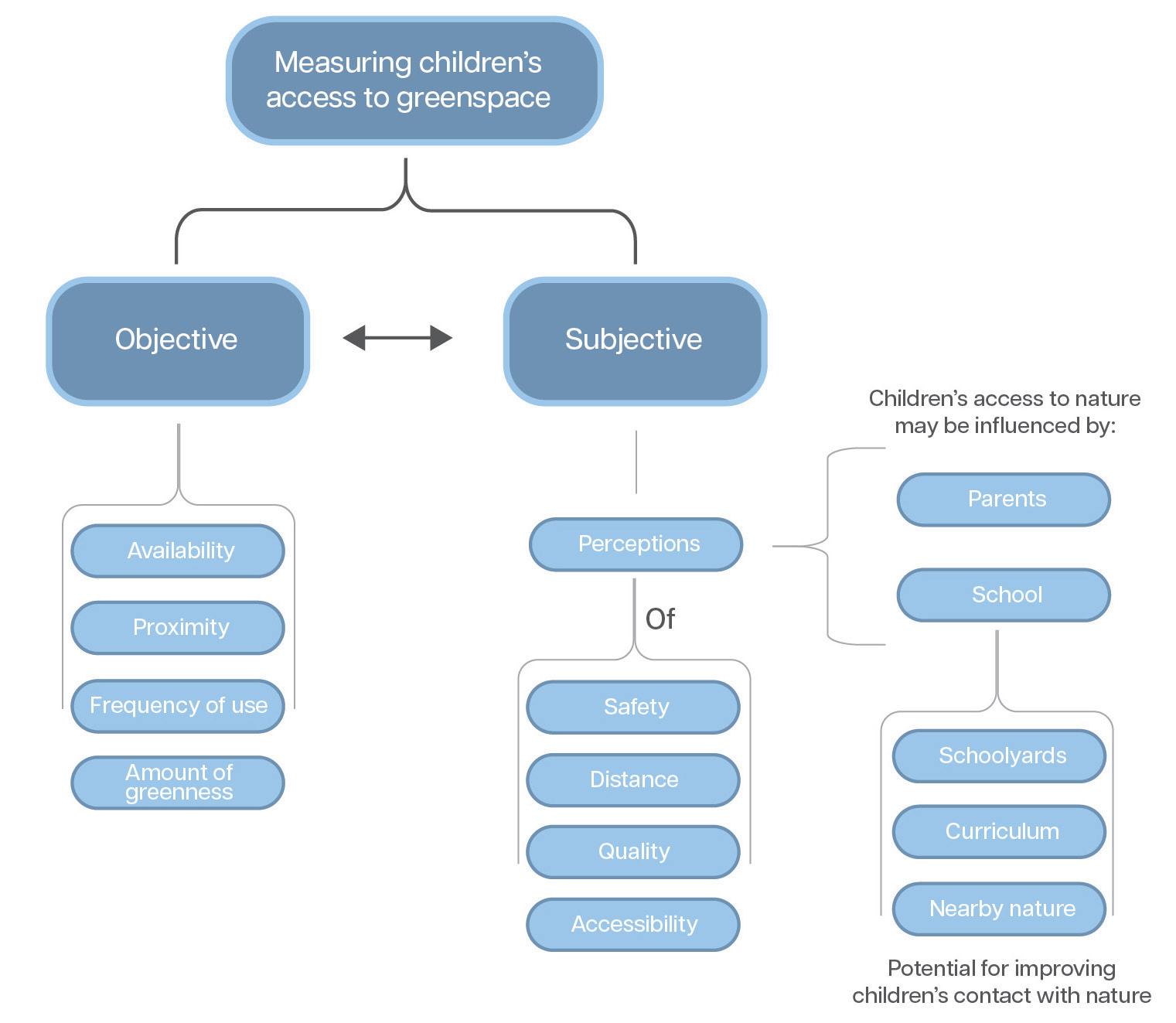

However, less research has considered other avenues for children’s contact with nature during school, especially in communities with a high proportion of low-income families where green schoolyards may be difficult to fund.
Because parents and schools play significant roles in young children’s lives, it is important to explore their perceptions including awareness of the benefits of nature, attitudes towards children’s contact with nature, and the barriers that may prevent time in nature, to suggest potential practical solutions for improving children’s access to nature within and outside of school. This study focuses on these factors to improve children’s access to nature in communities with low-income and racially minoritized families.

PART ONE PART TWO
Methods
Site Selection

KANSAS CITY, MO
With its historical redlining, Kansas City, Missouri remains one of the most racially segregated cities in the United States (González-Pérez, 2021). Racially minoritized communities still face structural and spatial inequalities that have negatively impacted their quality of life (González-Pérez, 2021). Therefore, it is plausible to select Kansas City as a case for this study.
SUITABLE CASE FOR EXPLORING CHILDREN’S ACCESS TO GREENSPACES IN LOWINCOME COMMUNITIES

MEDIAN HOUSEHOLD INCOME
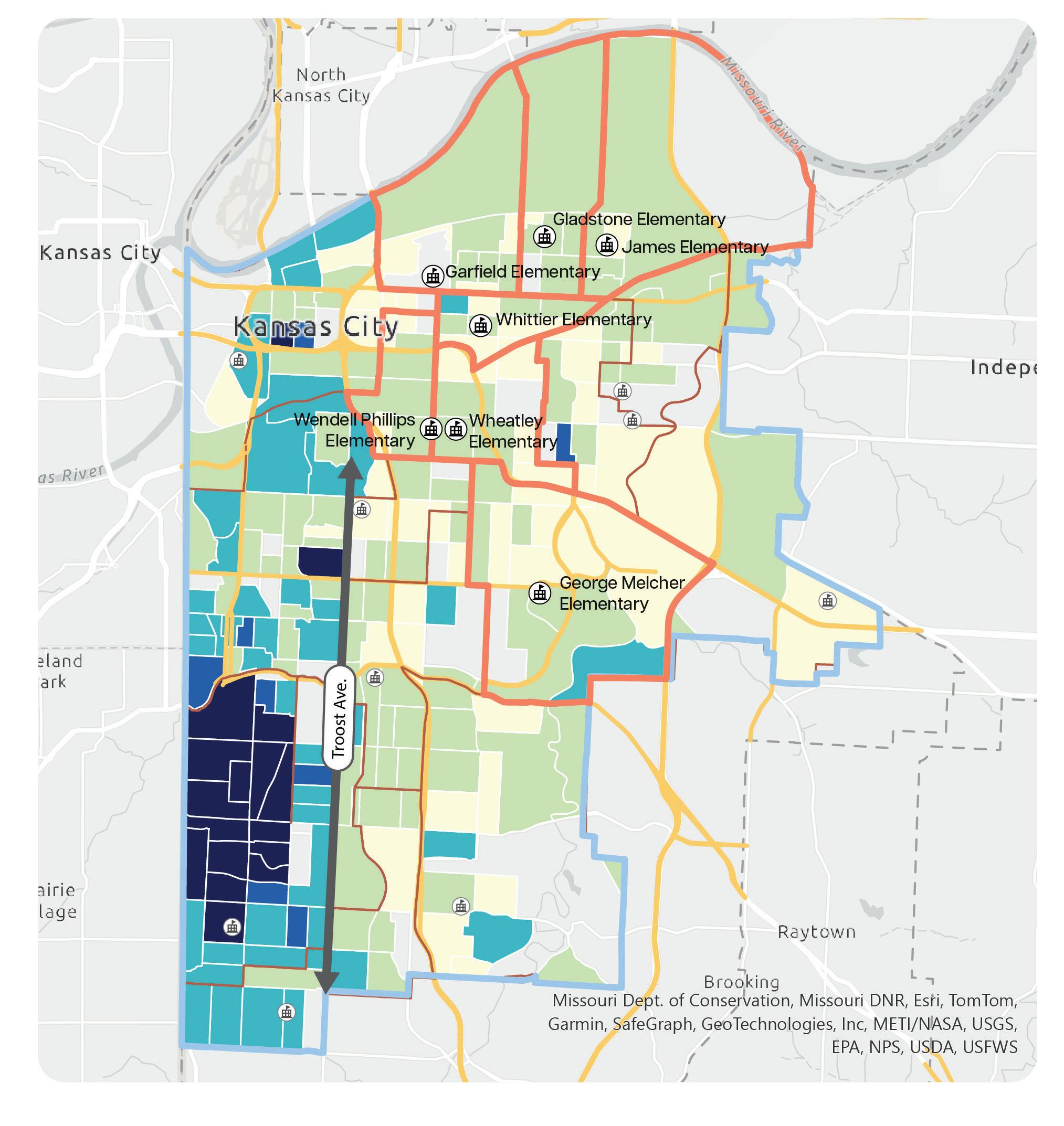
PERCENT OF POP. AGES 5-9

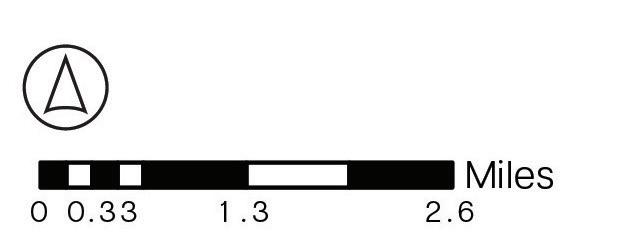
SCHOOL RECRUITMENT
The potential schools were contacted via email and phone call to be invited to participate in the study. School administration was contacted and provided with the following information about the study:
Research topic: Children’s contact with nature
Research method: Online survey
Research participants: Teachers and parents of children/students in K-6th grade
Goal of research: Identify potential challenges and opportunities for children’s contact with nature.
Outcome of research: Survey responses will be used to inform planning and design recommendations to create more opportunities for children to be in contact with nature.
SELECTED SCHOOL ATTENDANCE ZONE
Spatial analysis of socio-demographics, at the block group level, was used to identify school attendance zones within the KCPS district boundaries. The two socio-demographic factors used to select potential schools were median household income and percent of population between 5 and 9 years old. Overlaying the two socio-demographic factors of age and income, identified seven total potential schools.
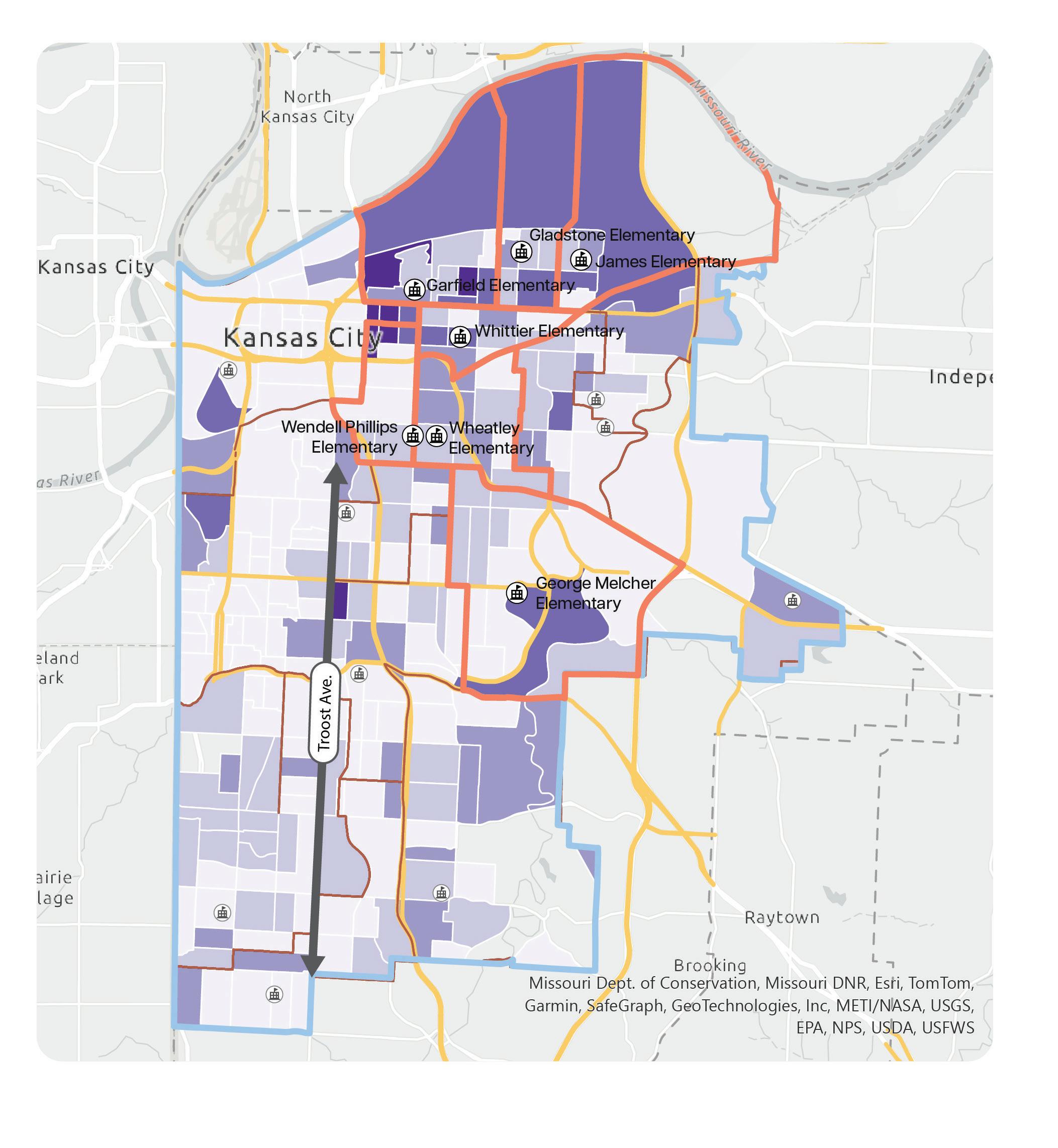



GLADSTONE ELEMENTARY SCHOOL

Greenspace Availability
GREENSPACE TYPES
A spatial analysis of greenspace availability within the school’s attendance zone gathered the types of greenspaces that were available to these communities in their neighborhoods and nearby the schools. This required a combination of mapping greenspace locations and sizes (acreage) through ArcGIS, classifying the greenspaces into types by remote site observations of physical features and space functions using Google Street View imagery, and reviewing greenspace information from the Kansas City Parks and Recreation Department.
Greenspaces were categorized into types decided by the researcher’s observations of their features/amenities, and function. Types include athletic parks, neighborhood parks, nature parks, and gardens. A quarter mile and half mile radius were drawn around the schools to show what greenspaces were nearby.



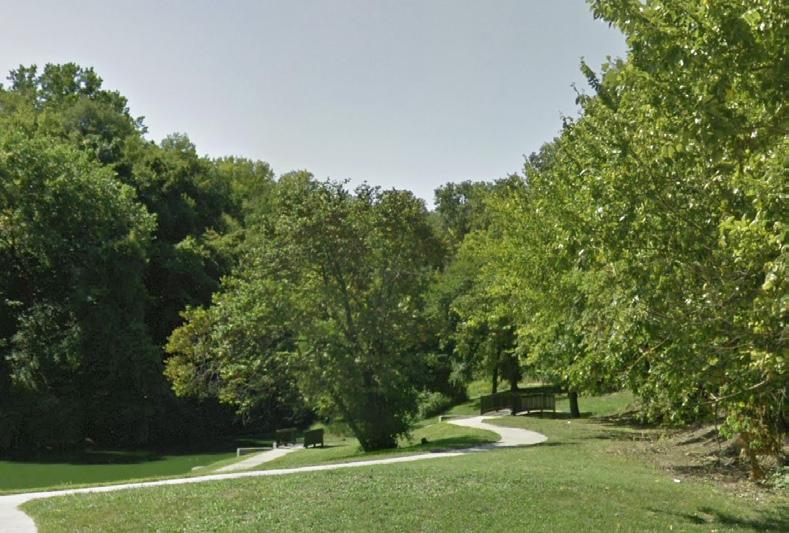

GREENSPACES NEAR GLADSTONE ELEMENTARY SCHOOL
Gladstone Elementary School and the surrounding neighborhoods have two greenspaces in the area, including a 300-acre nature park (Kessler Park) within a ¼ mile, or 5-10 minute walk, and a 26-acre neighborhood park (Budd Park) around a ½ mile, or 1020 minute walk. Both parks are rated by KCMOPRD as ‘fair’ in the 2015-2020 Master Plan, meaning, the park is in a state of decline, with less frequent maintenance, and in need of repairs and renovation.
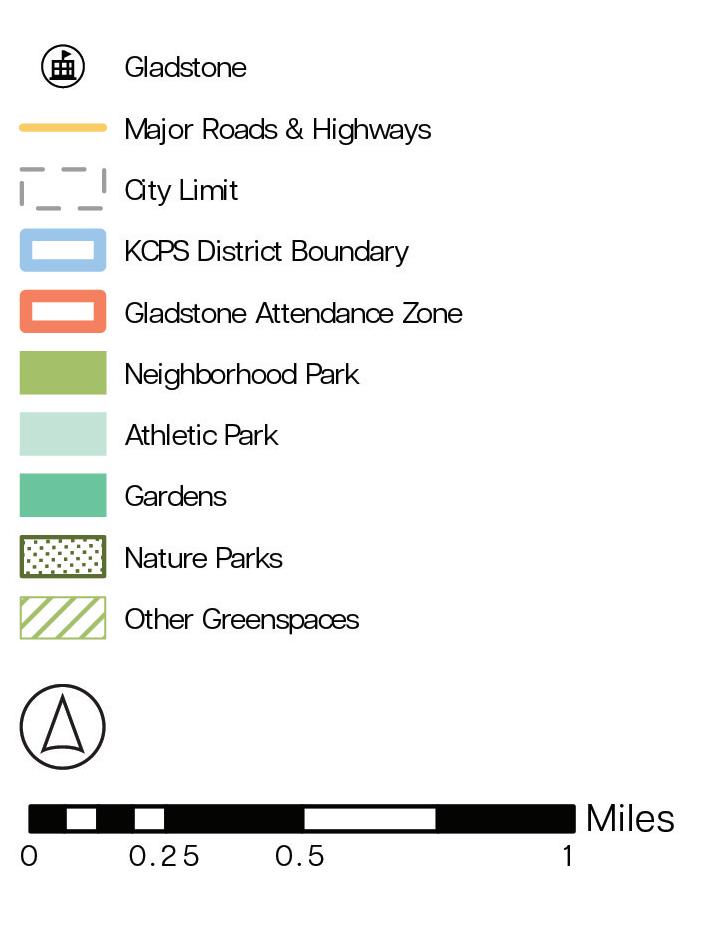
KESSLER PARK | NATURE PARK

BUDD PARK | NEIGHBORHOOD PARK

2 | KESSLER PARK
Acres: 303.51
Distance: 1/4 mile
Type: Nature Park
Overall Park Rating: Fair (KCMO Parks & Rec)
KEY FEATURES:
P - Pedestrian path
B - Marked bike lane
M - Mountain bike trail
D - Shared access drive (bikes, pedestrian & car)
L - Historic landmark
W - Body of water
G - Disc golf course
O - Scenic overlook
1 | BUDD PARK
Acres: 26.39
Distance from school: 1/2 mile
Type: Neighborhood Park
Overall Park Rating: Fair (KCMO Parks & Rec)
KEY FEATURES: P - Playground A - Athletic courts/ fields PS - Picnic shelters OF - Open field
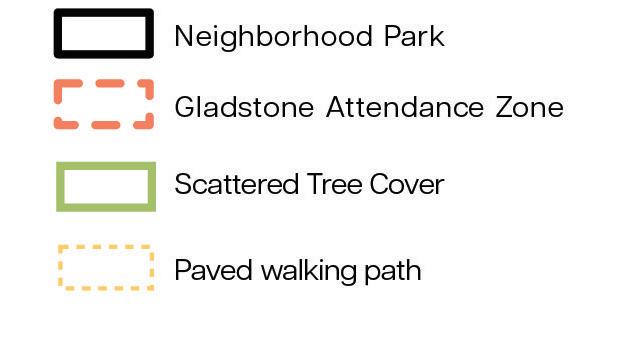
The portion of Kessler Park within the ¼ mile radius of Gladstone Elementary School has a paved walking path along the road, a shared path for cars and pedestrians, and hiking and mountain biking trails (Indian Mound Trail) situated within the dense wooded areas. There are no other amenities available in this area. However, in other parts of the park there are additional trails, a lake, several historic landmarks, and a disc golf course.
POTENTIAL TO PROVIDE CHILDREN WITH MORE OPPORTUNITIES TO BE IN CONTACT WITH NATURE
Budd Park is a large neighborhood park that is surrounded by residential areas and some small businesses. This park provides paved walking paths, a couple playground areas, basketball hoops, a baseball field, soccer field, and tennis courts. There is a large, central pavilion, along with smaller shelters near the playgrounds. This park also includes a community pool and pool house. Vegetation is limited to mown grass and trees. Tree cover is primarily clustered on the perimeter of the park, with some scattered trees throughout.
2
1
NEIGHBORHOOD PARK
NATURE PARK ATHLETIC PARK
GARDENS
Social Data Collection
MULTILINGUAL PHOTO-SURVEY
Photo surveys with a 5-point scale were used to collect data on three factors of perceived access to greenspace and contact with nature including attitudes, awareness, and barriers. Attitudes towards children’s contact with nature include the importance of contact with nature, time that should be spent in nature, and importance of outdoor learning in schools. Awareness includes knowledge about mental, behavioral, and physical health benefits of contact with nature.
Perceived barriers that may negatively influence children’s time and quality of experience in greenspace include walkability and safety. The survey also gathered parent and teacher preferences for different greenspace settings to take their children to and outdoor activities they want their children to do. Surveys for schools gathered more information on teachers’ preferences for outdoor or nature-based learning and challenges in the school system.
SURVEY CONTENT

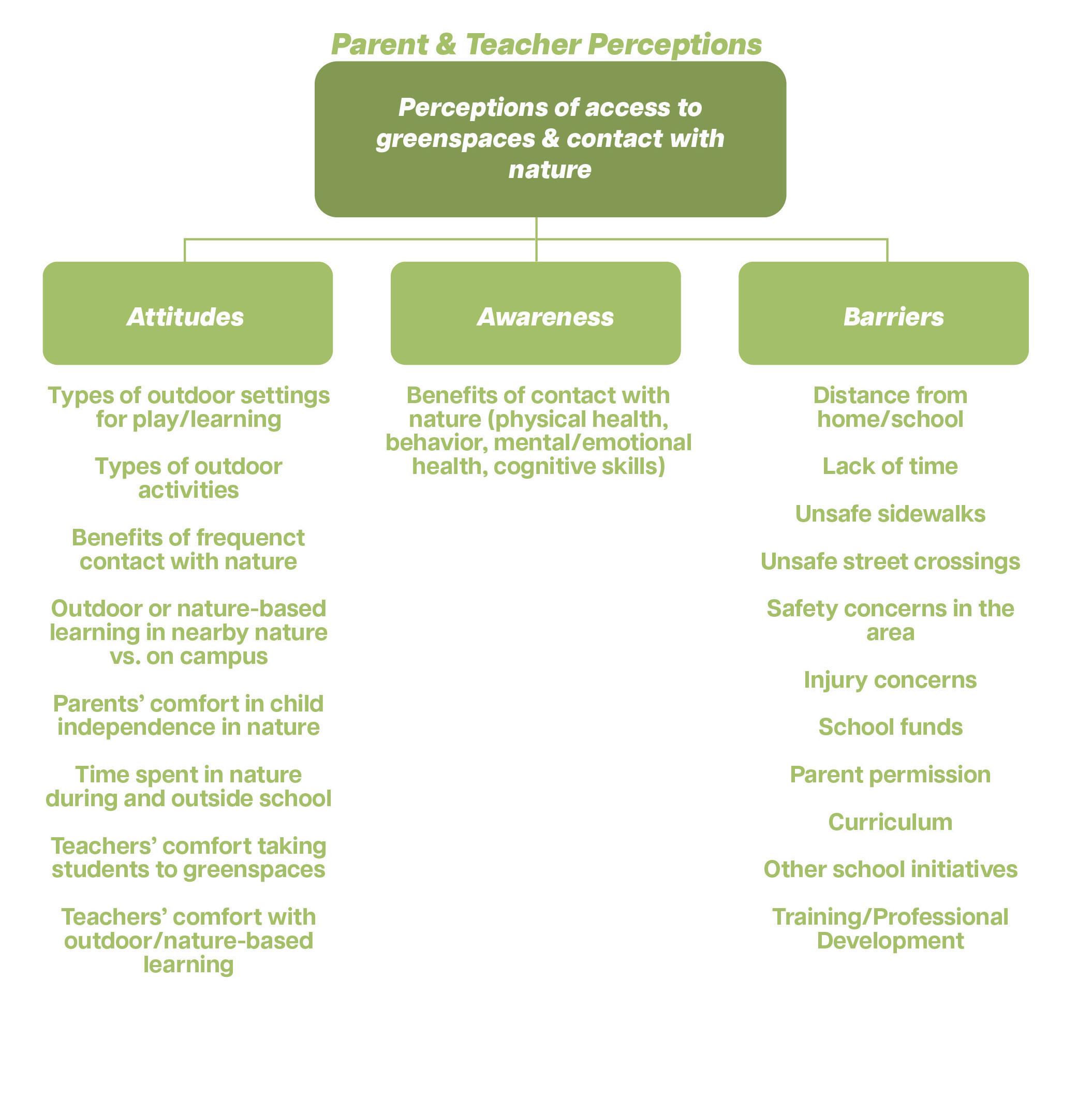


PARENT DEMOGRAPHICS (N=31)


TEACHER DEMOGRAPHICS (N=20)
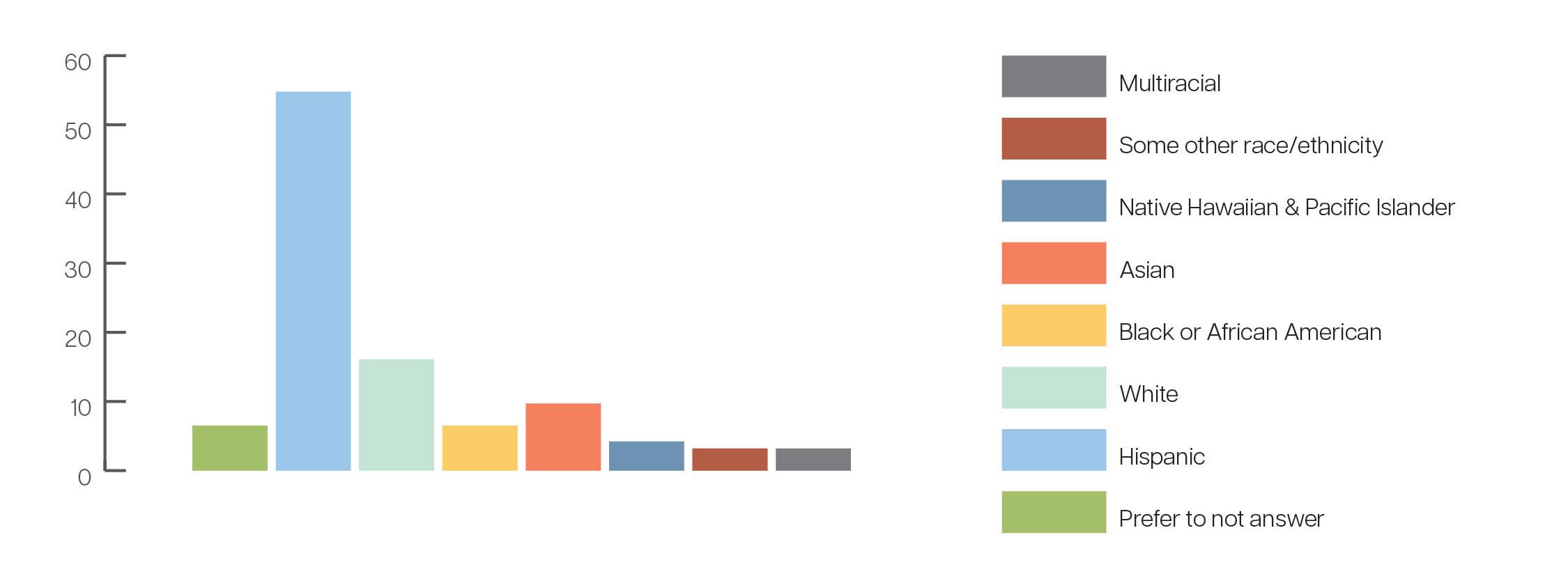



54.8% 32.3% Total household income before taxes (% parents) Highest degree or level of education (% parents) 71% 74.2% 71% of parents were mothers or stepmothers of parents were female of parents were married Race/Ethnicity (% parents) 54.8% 16.1% 6.5%9.7% 3.2% 3.2%3.2%3.2% Total household income before taxes (% teachers) Multilingual Photo Survey on Desktop & Mobile Device Highest degree or level of education (% teachers) 30% 25% 15% 10% 15% 55% 35% 70% 15% 5% 5% 5% 85% of teachers were female
Social Data Analysis Findings
STATISTICAL ANALYSIS
The collected data from the surveys was entered into the IBM Statistical Package for the Social Sciences (SPSS) 29 software for analysis. Data analyses include frequencies, Pearson bivariate correlations, factor analysis and reliability tests, and independent samples t-tests to understand the strength of and associations between different factors that may be related to children’s contact with nature.
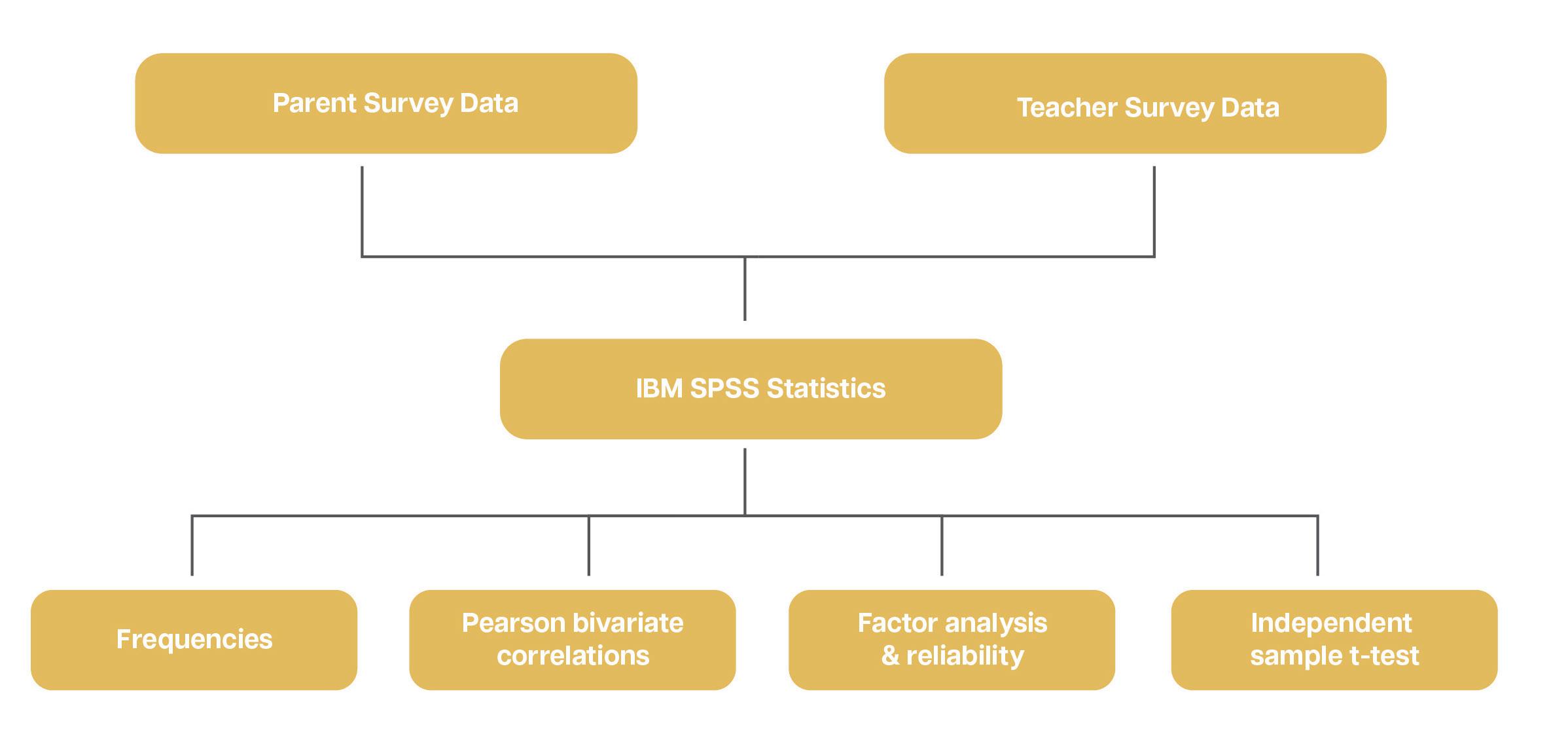
PROXIMITY TO GREENSPACES
Of the greenspace types that parents reported if they strongl disagreed to strongly agreed they live close to, neighborhood parks (mean = 3.48) and athletic parks (mean = 3.32) had a moderately-high mean value, nature parks had a moderately low mean value (mean = 2.81), and gardens had a low mean value (mean = 1.87).
Of the greenspace types that teachers reported if they strongly disagreed to strongly agreed their school was located close to, neighborhood parks had a moderate mean value (mean = 3.00), nature parks (mean = 2.65) and gardens (mean = 2.35) had a moderately low mean value, and athletic parks (mean = 1.35) had a low mean value.


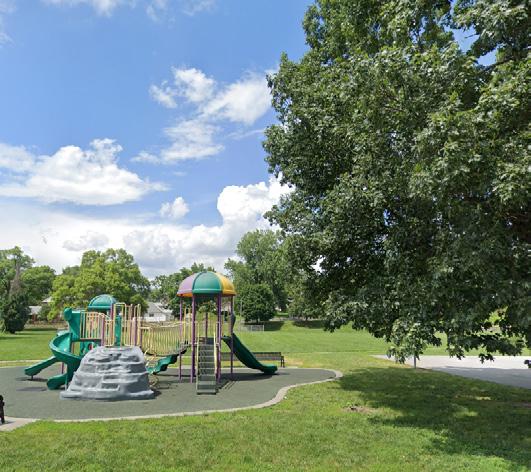
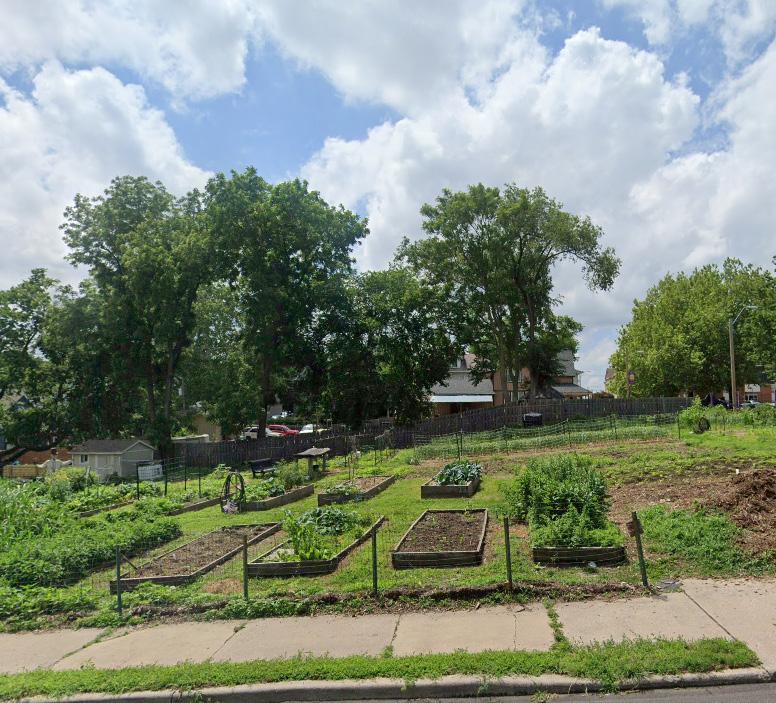


HOW FREQUENT PARENTS VS TEACHERS TAKE THEIR CHILDREN/STUDENTS TO GREENSPACES
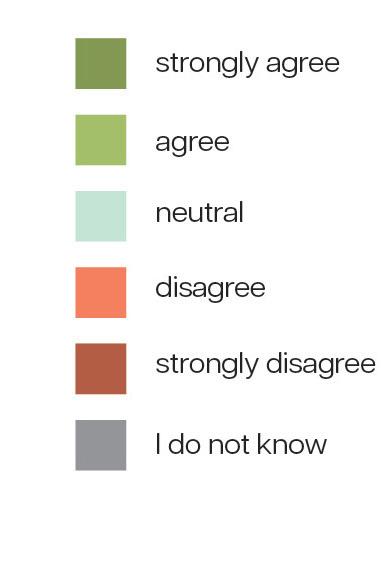
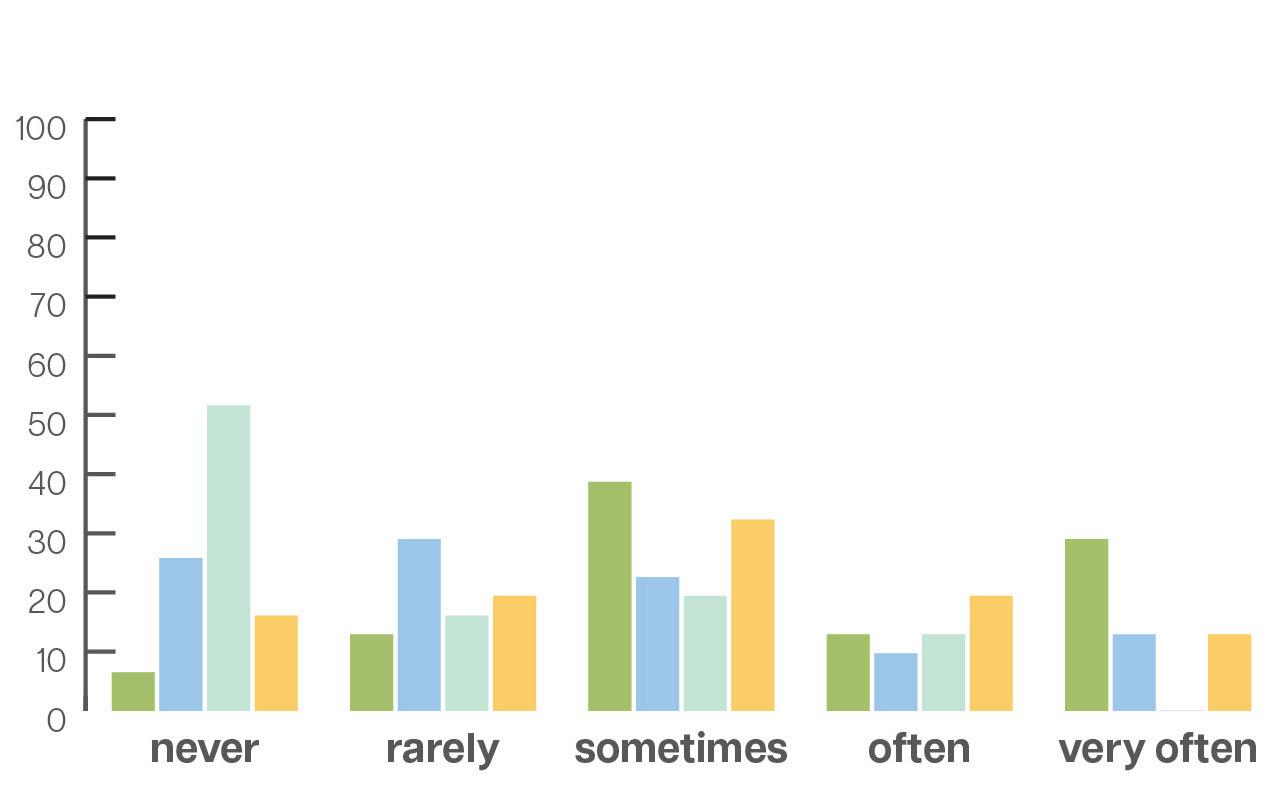
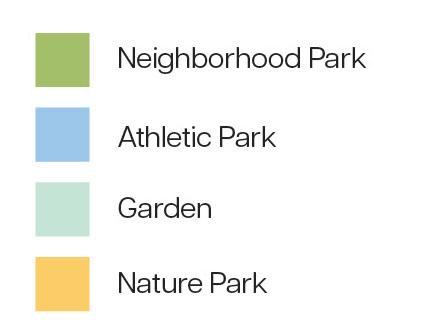


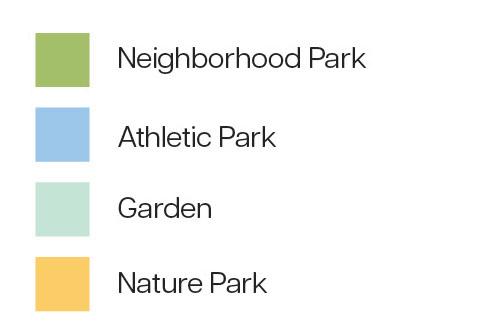
The independent sample t-test showed statistical significance for how frequently parents versus teachers took their children/students to neighborhood parks (t = 5.247, p < .001), athletic parks (t = 5.796, p < .001), and nature parks (t = 5.432, p < .001). A high Cohen’s d effect size (d > 0.7) showed there were statistically significant differences. Parents took their children to these greenspaces more often, especially to neighborhood parks which had a moderately high mean value; however, the mean value for nature parks and athletic parks was still within the moderately low mean value range. Teachers took their students to these greenspaces rarely to never, indicated by the low mean values. There was no statistical significance for how frequently parents and teachers took their children/students to gardens. Both mean values were below 2.00, meaning most parents and teachers did not take their children/ students to gardens.
41.9% 35.5% 38.7% 35.5% Neighborhood parks Athletic parks Gardens Nature parks 35% 35% 20% 25% 35% 30% 30% 25% 30% 25% Neighborhood parks Athletic parks Gardens Nature parks
school is located close to a public greenspace like this (% teachers)
I live close to a public greenspace like this (% parents) Our
low 1.0 - 1.99 moderately low 2.0 - 2.99 moderately high 3.0 4.0 high 4.1 5.0 Not statistically Neighborhood Parks Neighborhood Parks Athletic Parks Athletic Parks Gardens Gardens Nature Parks Nature Parks 3.45 1.65 2.55 1.10 1.94 1.65 2.94 1.40 parents (n=31) teachers (n=20) Difference
Values Statistically different Mean Value Ranges
How frequently do you take your children to public greenspaces like this?
in Mean
How frequently do you take your children to public greenspaces like this? (% parents) How frequently do you take your students to public greenspaces like this? (% teachers)
Social Data Analysis Findings
SAFETY & WALKABILITY BARRIERS
‘Safety concerns in the area’ and ‘unsafe street crossings’ were consistently moderately high barriers for both parents and teachers for taking their children/ students to most greenspaces. This was supported by additional safety concerns parents identified (i.e., crime, drugs/alcohol, maintenance, bad neighborhood). Both parents and teachers agreed that distance to gardens was a moderately high barrier, as there were no gardens in the area. For teachers, ‘lack of time’ was a moderately high barrier for all greenspaces, ‘distance from school’ was moderately high and high for neighborhood parks and athletic parks, and ‘unsafe or disconnected sidewalks’ was moderately high for athletic parks and nature parks.
There were only a few correlations between how frequently parents took their children to greenspaces and barriers. For teachers, there were more correlations between how frequently or comfortably they were taking their students to greenspaces, especially for gardens, and walkability and safety barriers.
Mean Value Ranges
low 1.0 - 1.99
- 2.99
- 5.0
OTHER FACTORS:
(1) GUNSHOTS/DRIVE BY SHOOTINGS
(2) BAD NEIGHBORHOOD
(3) DRUG/ALCOHOL CONTAINERS
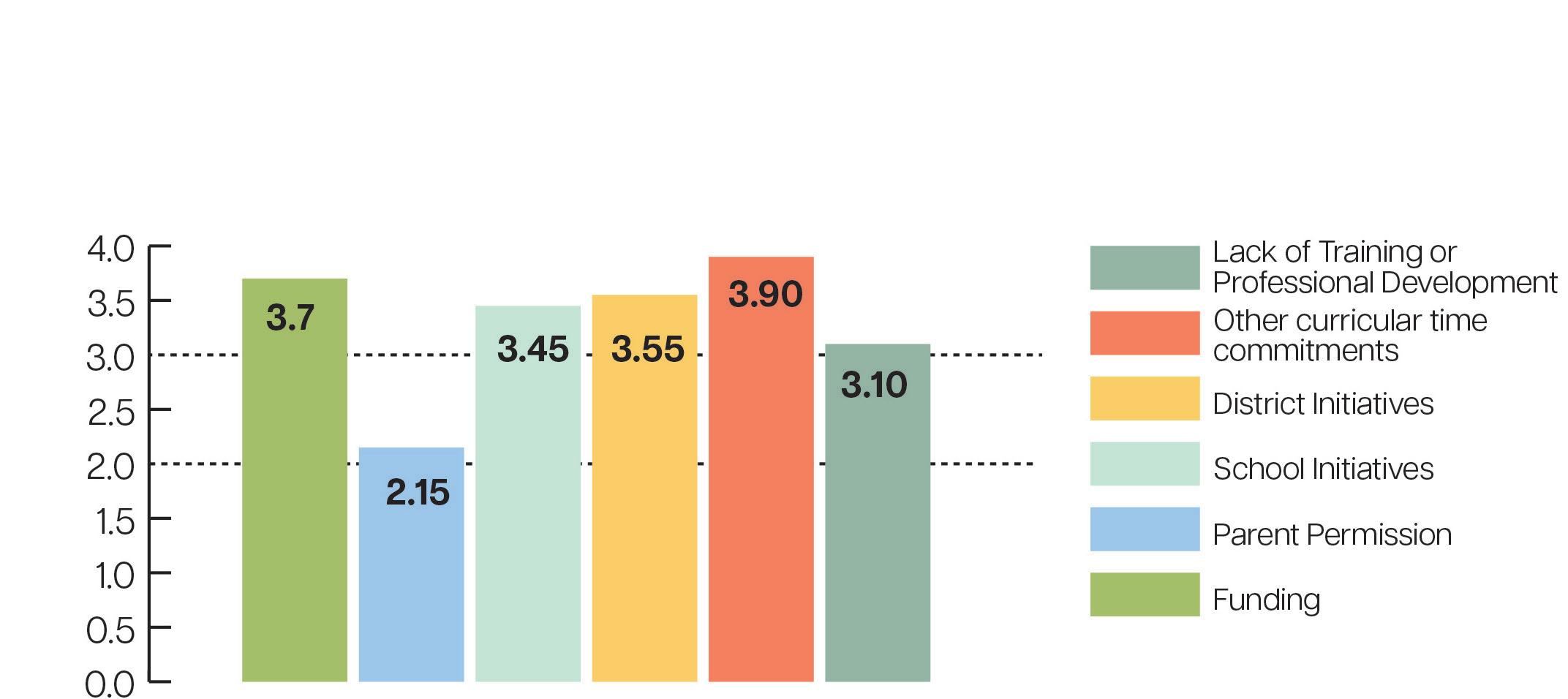
(4) LACK OF AREA MAINTENANCE
(5) AGGRESSIVE DOGS
(6) NEED MORE SUPERVISION FOR CLASSES
(7) NO FUNDING
No statistical significant difference in mean values (parents & teachers)
Lack of Time Distance Unsafe or disconnected sidewalks Unsafe street crossings Safety concerns in the area Injury concerns Neighborhood
What other barriers do teachers face for providing outdoor or nature based learning?
I feel comfortable incorporating outdoor or nature-based learning in my lessons

How frequently do you incorporate outdoor or naturebased learning in your lessons?

outdoor learning
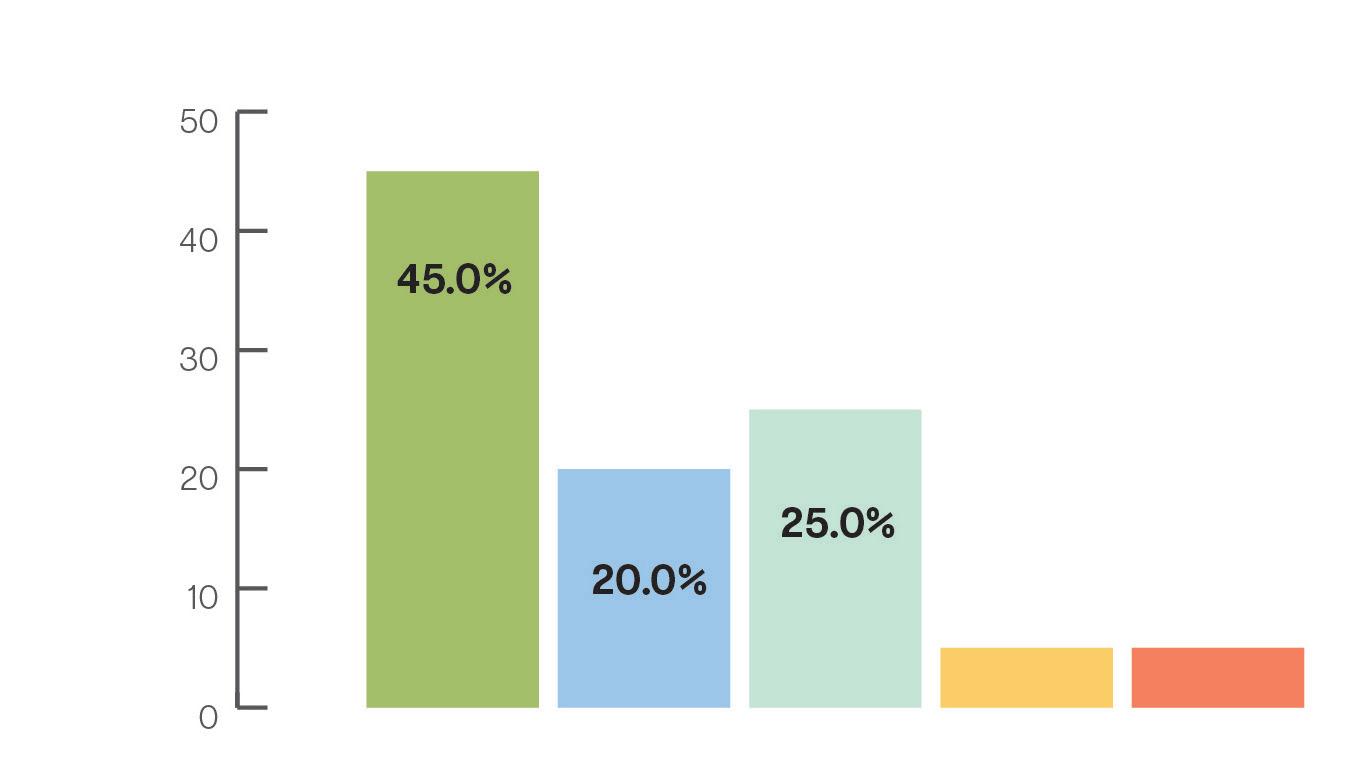
nature-based learning
SCHOOL-SPECIFIC BARRIERS
Teachers experience additional barriers that may not allow visits to greenspaces or having outdoor or nature-based learning in lessons. Based on students’ low-academic levels, having a specific curriculum, the MAP testing requirements, and other school-specific barriers (i.e., district initiatives, school initiatives, lack of funding, training or professional development), it does not seem the school includes time for outdoor or nature-based learning. Funding and training or professional development may also be focused on the specific curriculum needs, and not nature-based learning.
of teachers disagreed to strongly disagreed their school organizes enough outdoor or nature-based learning in the curriculum 60%
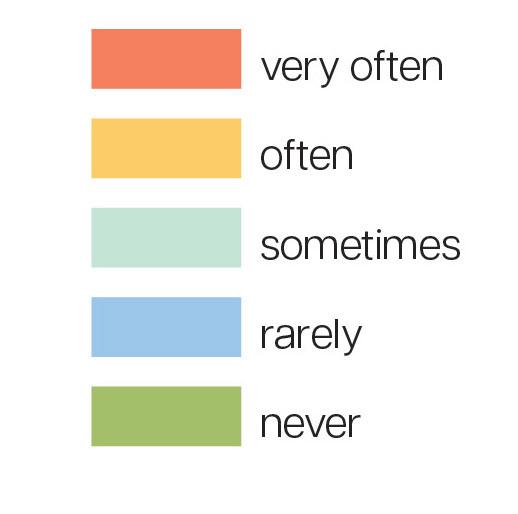
of teachers agreed frequent contact with nature during school time was important 80%
“PERHAPS DUE TO THE VERY LOW ACADEMIC LEVELS OF THE MAJORITY OF THE STUDENTS, THE SCHOOL IS TIED HEAVILY ON CERTAIN CURRICULUM. THERE'S NO TIME TO VENTURE OUT IN NATURE.”
“IT’S NOT ON MAP TESTING”
“I TEACH MATH, SO SOMETIMES AT THE END OF THE YEAR I TAKE THEM OUTSIDE TO DO SOME WORK, BUT WE DON'T REALLY DO MUCH OTHER OUTDOOR LEARNING/EXPLORING ASIDE FROM FIELD TRIPS AND RECESS”
Garden Nature
Neighborhood Park Teacher Parent Teacher Parent Athletic Park Teacher Parent Teacher Parent Teacher Parent Garden Teacher Parent Nature Park Teacher Parent Teacher Parent Statistical significant difference
values
Distance
Park Athletic Park
Park
in mean
(parents & teachers) Lack of Time
Unsafe or disconnected sidewalks
moderately low 2.0
moderately high 3.0
high 4.1
- 4.0
Social Data Analysis Findings
ATTITUDES & AWARENESS
I consider myself knowledgeable about how frequent contact with nature affects children’s...
I feel my children/students should have frequent contact with nature to improve the following...
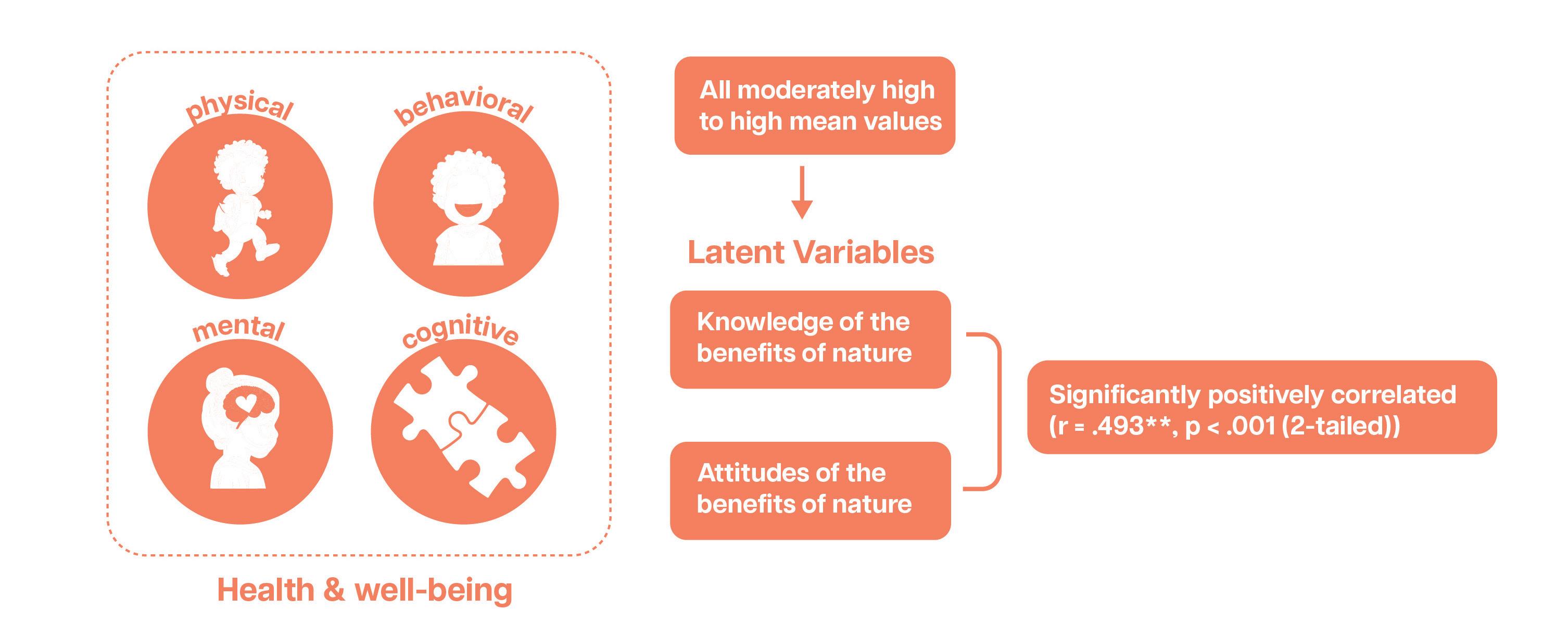
PARENTS AND TEACHERS WERE KNOWLEDGEABLE AND THINK NATURE IS IMPORTANT FOR ITS HEALTH BENEFITS
LOCATION OF OUTDOOR/ NATURE-BASED LEARNING

support outdoor or nature-based learning but only on the school campus would support supervised outdoor or nature-based learning in public greenspaces outside the school campus

parents (n=31) teachers (n=20)
PREFERENCES FOR OUTDOOR ACTIVITIES & SETTINGS
Both parents and teachers liked all outdoor settings (i.e., nature trail, playground, athletic fields, outdoor classroom, and more) shown in the photo questions (means > 4). They also liked all outdoor activities. The independent t-test showed there were no statistically significant differences between groups.
What outdoor activities do parents and teachers like for their children/students to do during or outside school time?
PARENTS & TEACHERS LIKED TO STRONGLY LIKED ALL OUTDOOR ACTIVITIES | ALL MEAN VALUES > 3.84
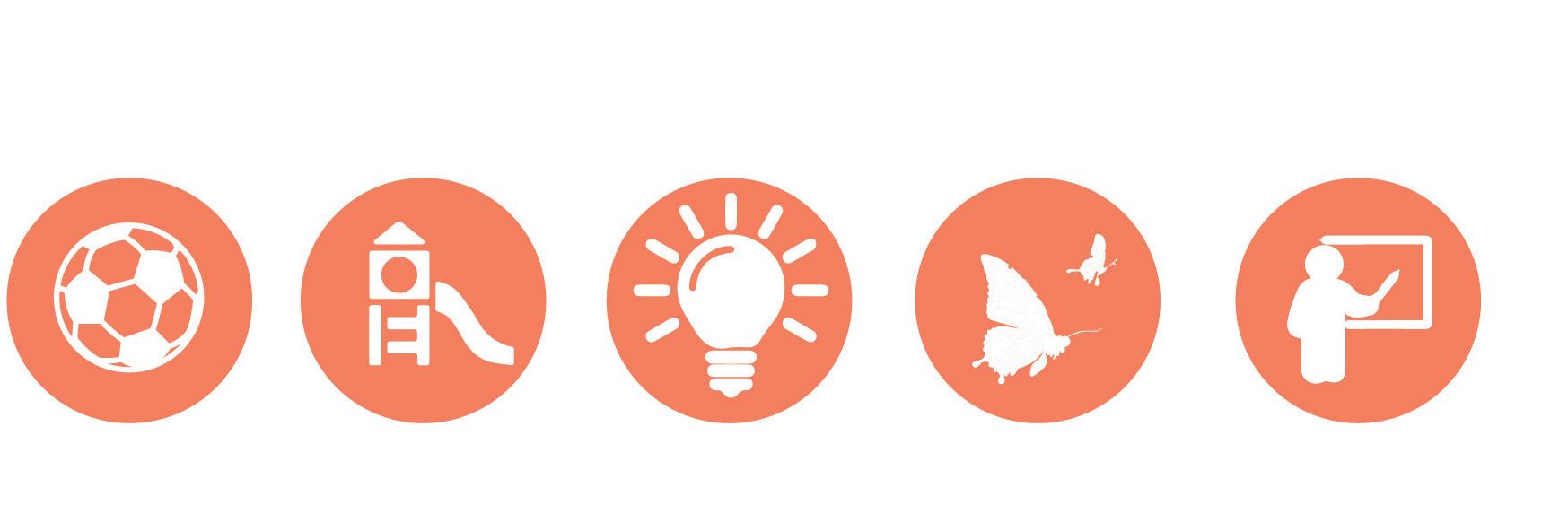
What outdoor settings do parents & teachers like for their children and students to play and learn in?
PARENTS & TEACHERS LIKED TO STRONGLY LIKED ALL OUTDOOR SETTINGS | ALL MEAN VALUES > 4.0 (PARENTS & TEACHERS)
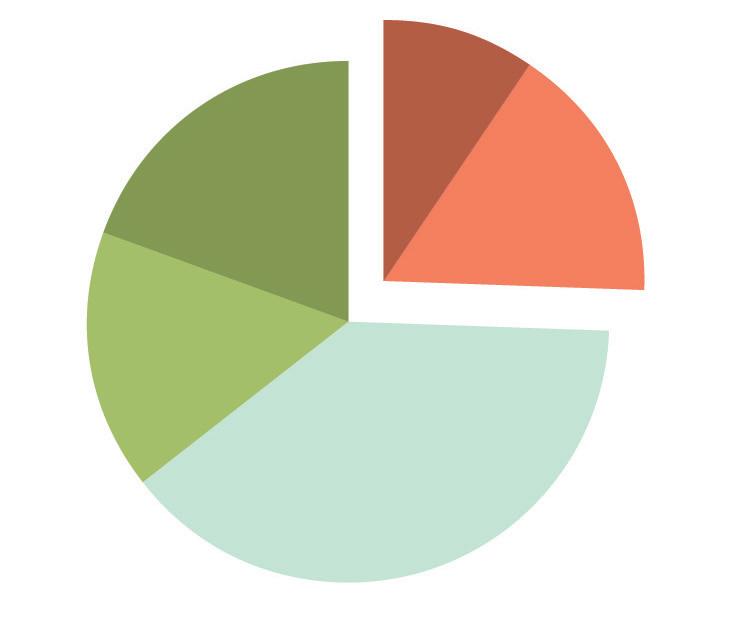
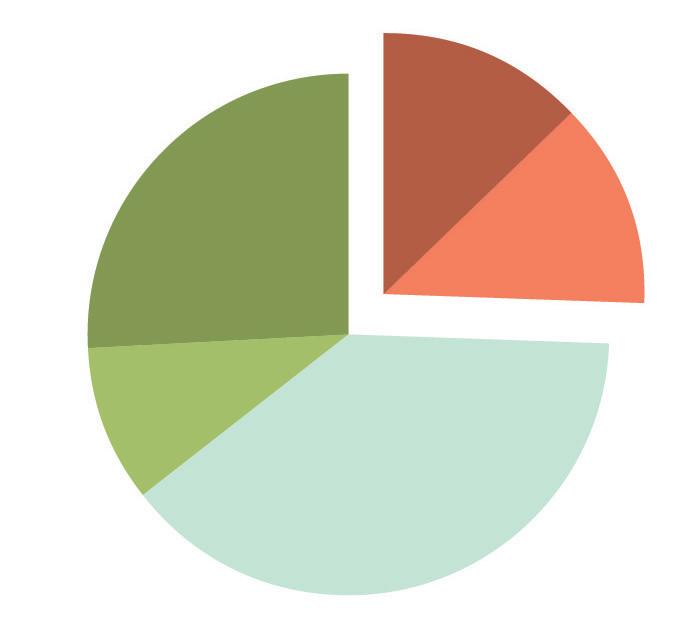
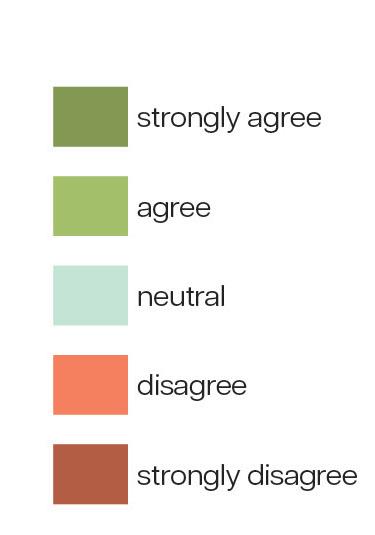
NOT STATISTICALLY DIFFERENT MEAN VALUES = PARENTS AND TEACHERS SUPPORTED OUTDOOR OR NATURE-BASED WHETHER IT WAS ON CAMPUS OR IN PUBLIC GREENSPACES
How frequently do children/students do these types of outdoor activities during or outside school time?
OUTSIDE OF SCHOOL

DURING SCHOOL sports play on playground imaginative play outside nature learning/ exploration learning in outdoor class

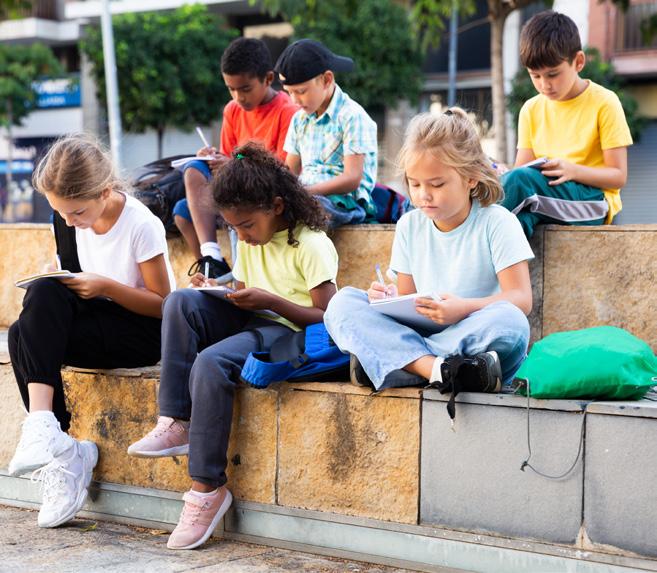
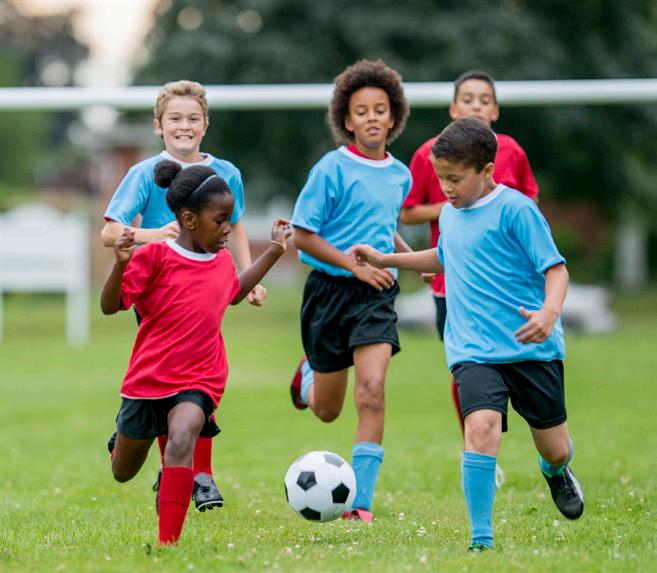

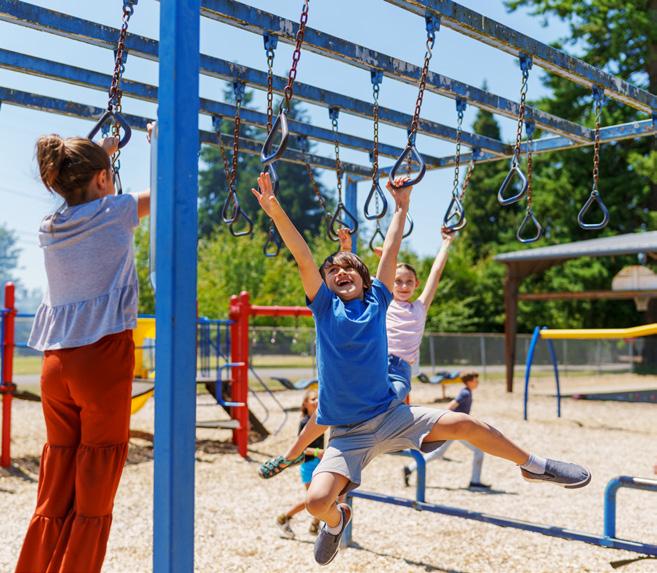

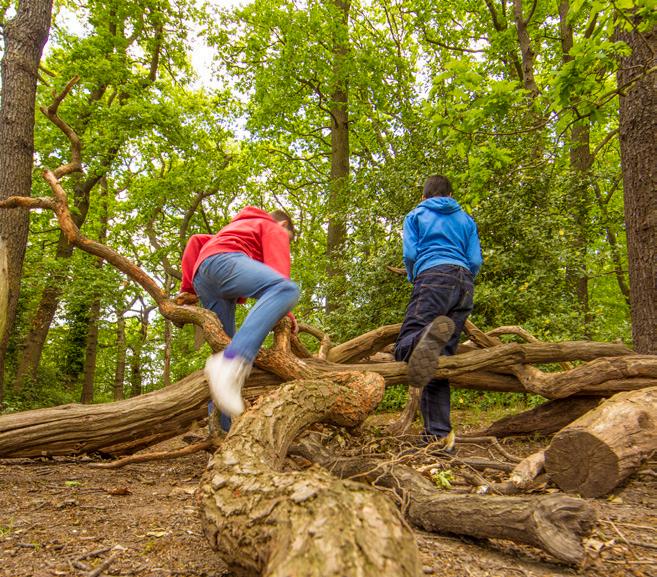
Parents | I think my children DO NOT spend enough time in nature during or outside of school time during school outside school 38.7% 38.7% 19.4% 16.1% 9.7% 25.8%
strongly agree strongly agree strongly disagree strongly disagree would
Planning & Design Recommendations
The following recommendations were based on landscape architecture and planning perspectives for addressing the findings from the literature review, social data analysis, and greenspace availability assessment. However, the issue of improving children’s equitable access to and contact with nature is an interdisciplinary issue that requires collaboration between educators, community members, planners, landscape architects, local governments, parks and recreation, to non-profit organizations. This research was only conducted in Gladstone Elementary, so there is a need to expand this research across the district and city to understand what greenspaces are available to each school and the surrounding neighborhoods,
the natural features they provide, what may prevent children from accessing those greenspaces, and what opportunities there are for increasing children’s contact with nature.
Responding to the spatial and social analyses findings, a set of goals were created to improve children’s contact with nature in the study area. Responding to these goals, various design strategies were suggested to support planning for children’s contact with nature in the city. The following sections are a phasing plan to implement these strategies in the study area. In addition, potential partnerships, resources, and funding opportunities were provided to support these efforts.
Goals Strategies
Provide more diverse nearby outdoor experiences for children in their neighborhoods.
Provide nature-based learning spaces in outdoor settings for school use
RE-ENVISION EXISTING GREENSPACES
CREATE SAFE ROUTES TO SCHOOL AND GREENSPACES
Improve walkability in neighborhoods
Improve perceptions of safety
TRANSFORM VACANT OR UNDERUTILIZED LAND
Support children's contact with nature in education
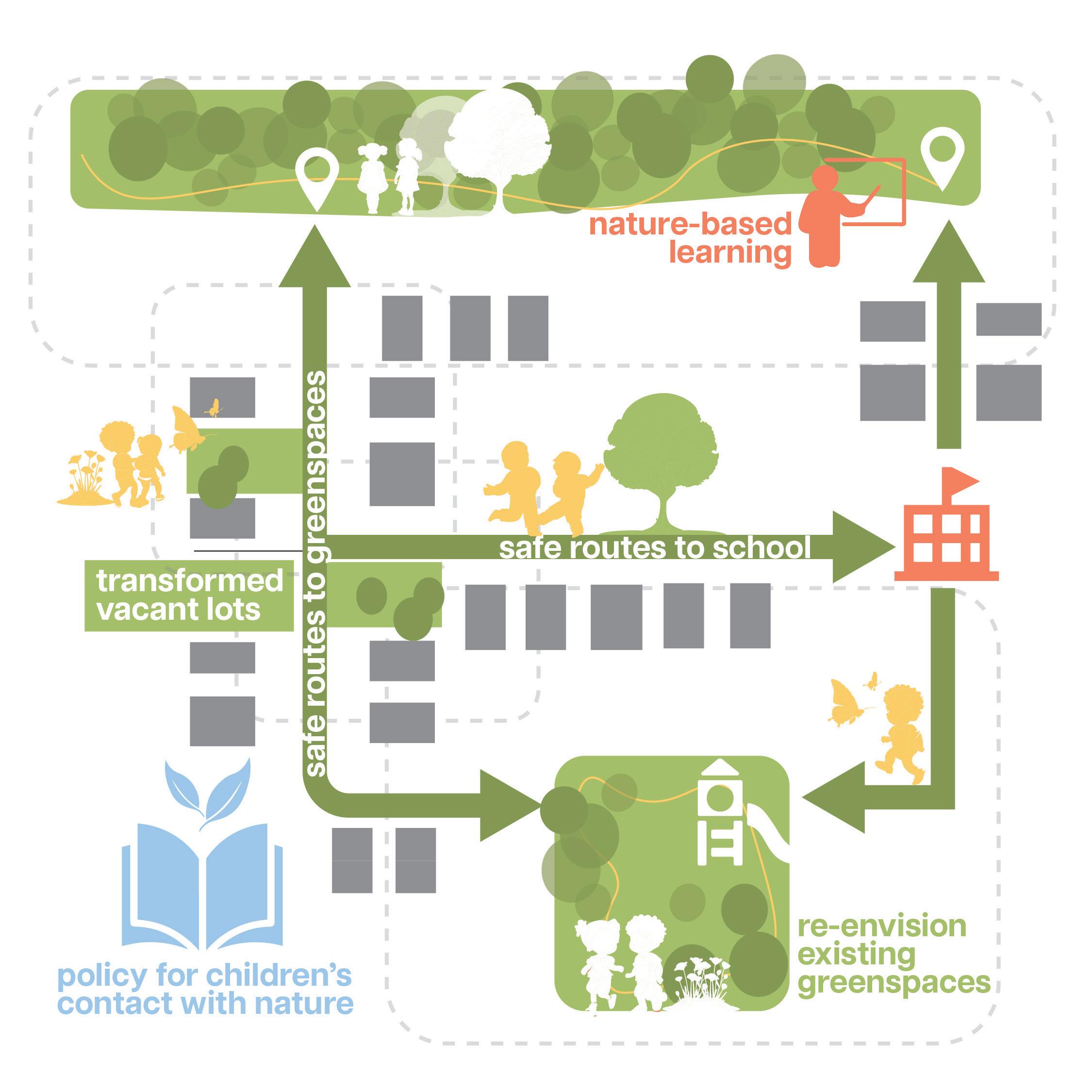
1 2 3 4 5
POLICY CHANGE
OVERVIEW
Re-Envision Existing Greenspaces
OVERVIEW
Existing greenspaces in communities, such as neighborhood parks, can provide more opportunities for children to interact with nature. While many parks provide recreational opportunities (i.e., athletic courts/fields, walking paths, playgrounds), they often lack natural elements and spaces for children to engage with. To provide children with rich outdoor experiences requires a diversity of environments for them to explore, be creative, and challenge themselves. To do so, parks and public spaces can incorporate natural elements such as gardens, nature playgrounds, nature trails, and more. In addition, these spaces may already be places that children go to and will benefit from adding nature play and learning spaces, or they may be places children do not use as much, so adding nature play and learning spaces can create new opportunities.


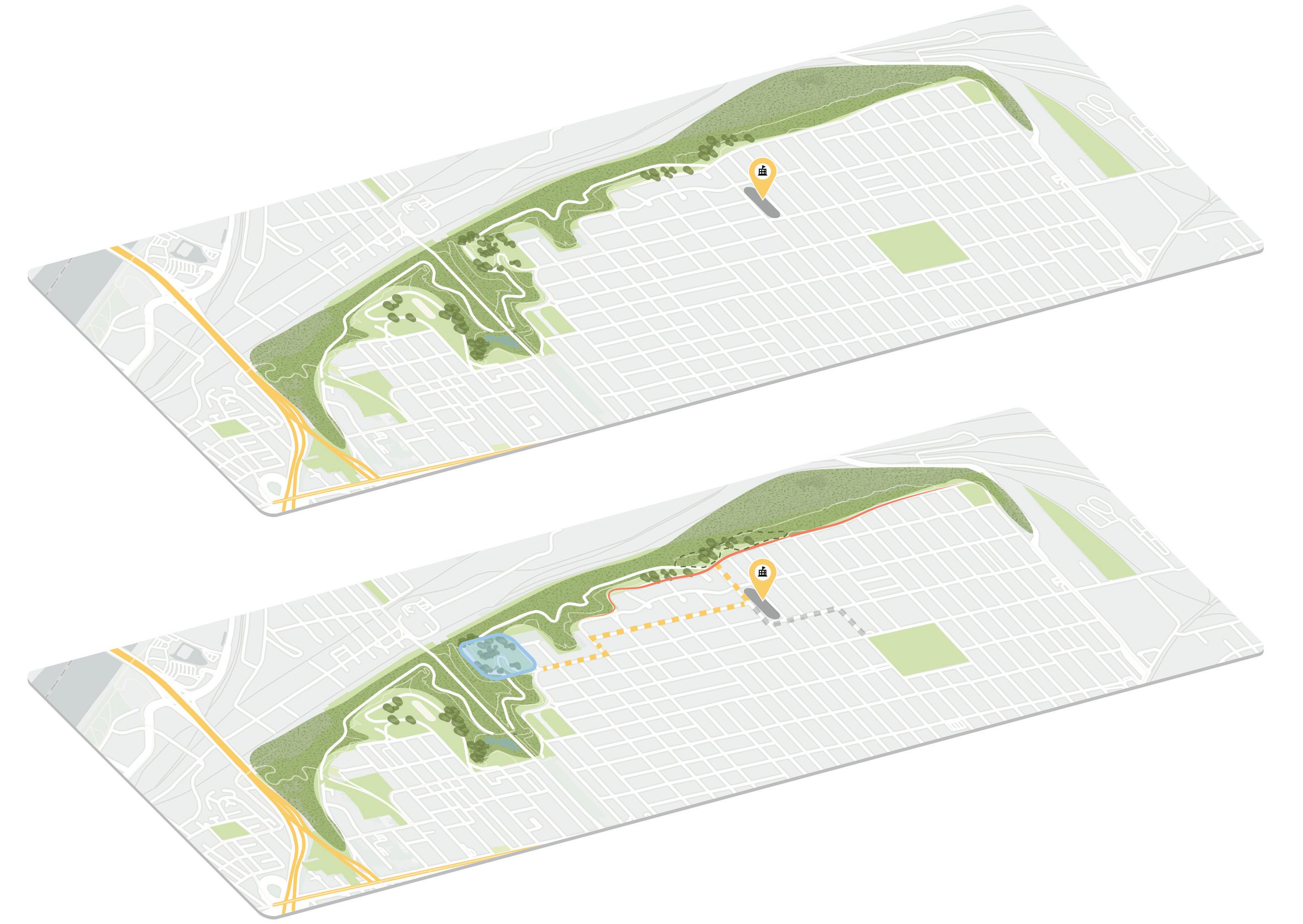
In the immediate area of Gladstone Elementary School’s attendance zone, there is a densely wooded area with mountain biking trails, shared-use lanes, and paved walking paths. Based on the greenspace availability assessment, there were not many opportunities for children to use this space besides the paths/trails. In addition, despite parents and teachers liking nature settings for their children to play and learn in, they frequented nature parks less. Additionally, many teachers were unaware of a nature park nearby the school despite it being within a 5-minute walk of the school.

Restored ecosystems can provide a nearby resource for schools to learn about ecosystems and wildlife.
DESIGN SUGGESTIONS FOR KESSLER PARK
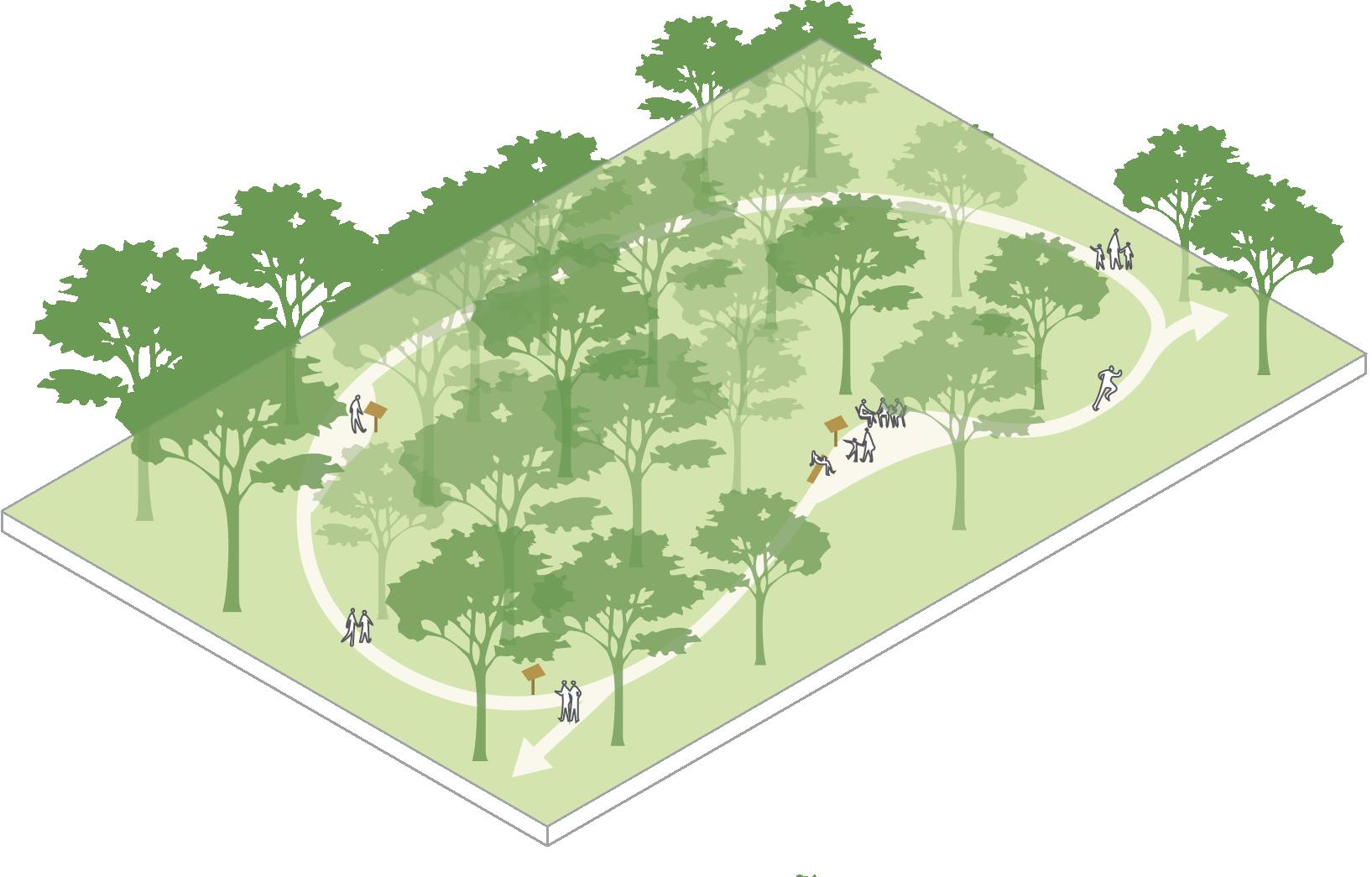
Children’s Nature Trail
Providing several options of trail lengths that loop can improve accessibility and may encourage children and families to use this nature park.

Incorporating more vegetated areas, small gathering or rest areas, or play opportunities along paths can create an engaging walking experience and places to stop along the way.
Budd park Budd park Gladstone Elementary Gladstone Elementary 1.0 mile 0.2miles 0.4 miles nature education center shared-use lane mountain biking trail dense forested area paved walking path child-friendly nature trail loop enhanced walking path Kessler Park Existing Conditions Kessler
wayfinding & educational signage short trail loop (0.25 mile) connection to other trails gathering/rest areas wooded areas
Park Design Suggestions
nature play space vegetated buffer pollinator garden where path bends wayfinding & educational signage wooded area Enhanced
Paved Walking Path
nature trails study stations restored ecosystems Nature
Education Center
1
Re-Envision Existing Greenspaces
DESIGN SUGGESTIONS FOR NEIGHBORHOOD PARKS
Budd Park provides a variety of outdoor recreation features including playgrounds, athletic fields, courts, walking paths, a community pool, and picnic shelters. While there are many recreational opportunities, this park does not have nature play or learning opportunities. Since the neighborhood park was identified as the closest and most frequented greenspace that parents took their children to, introducing nature play elements can provide children with additional spaces to engage in nature activities while retaining the existing park features. Existing Conditions
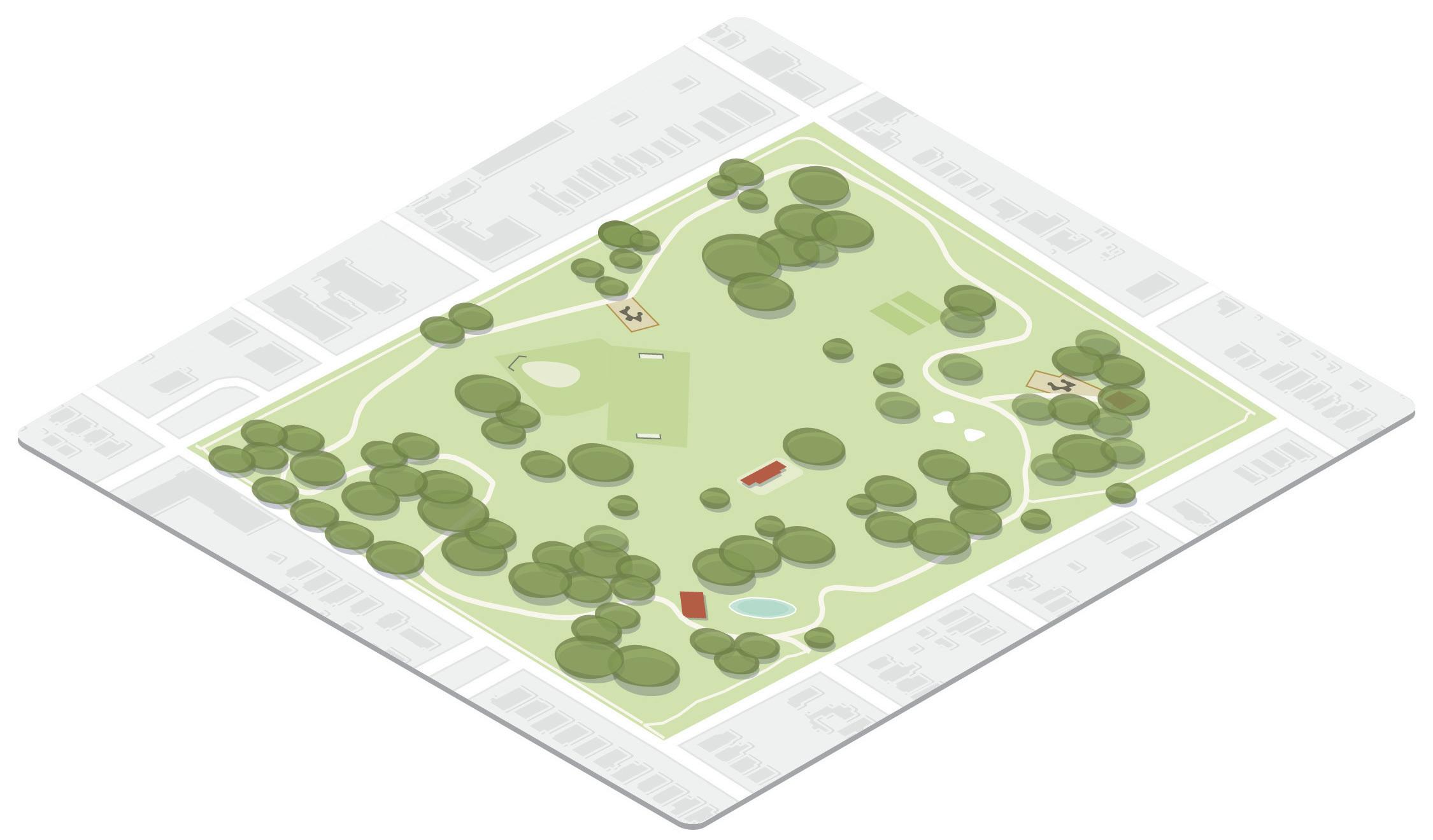
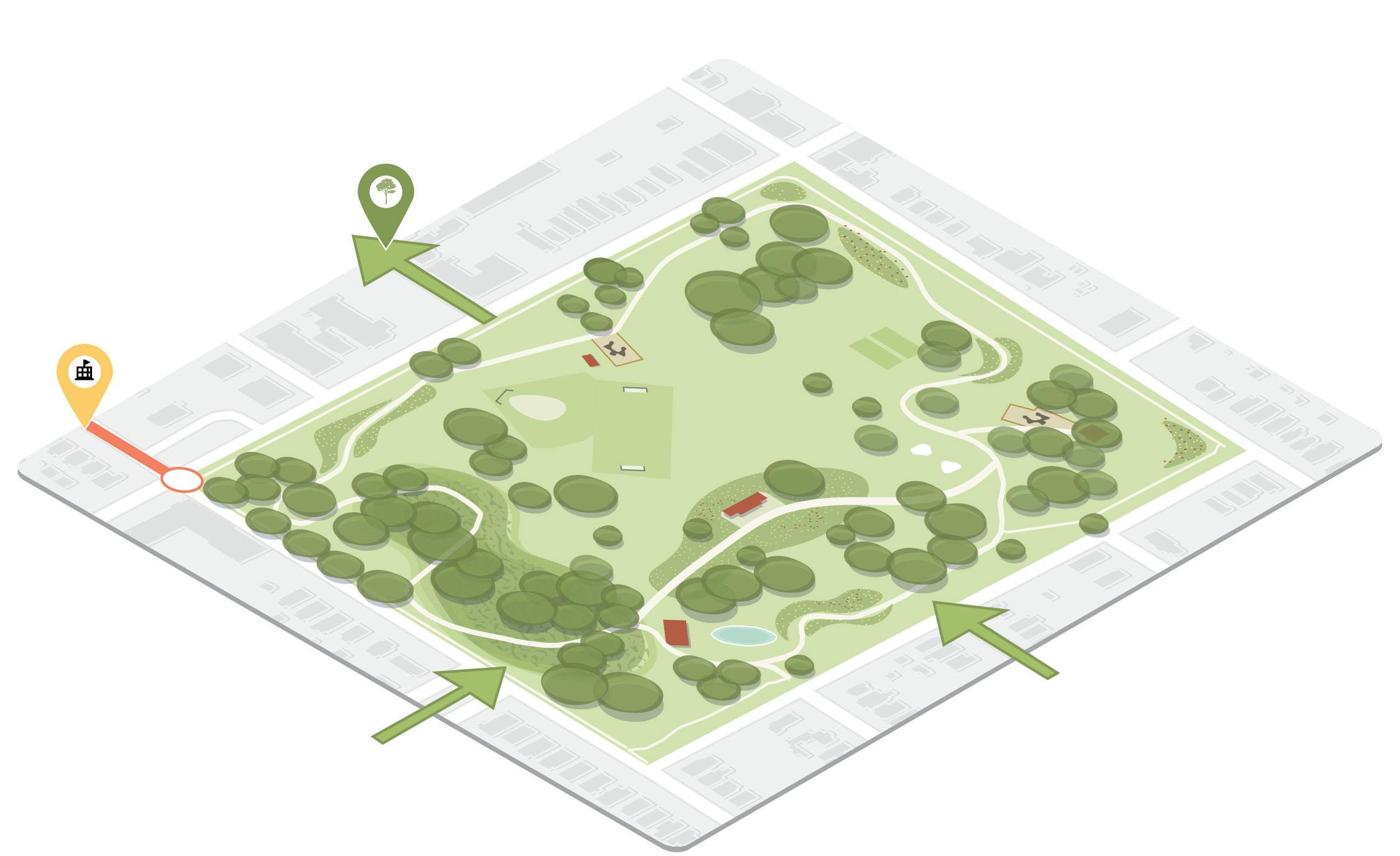
Suggestions for Budd Park
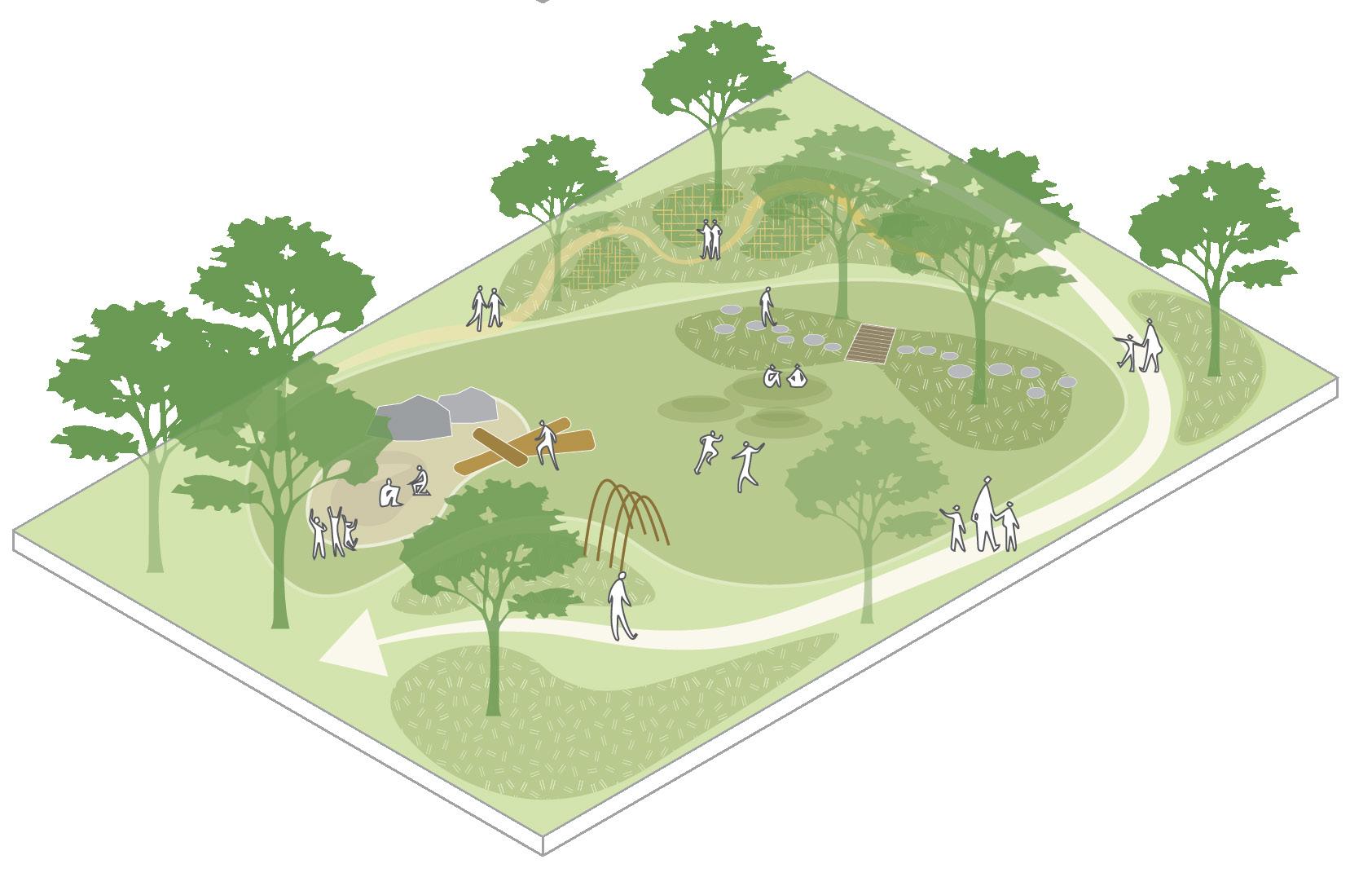
Allow children to play in an unstructured environment, challenge themselves physically, interact with materials, engage their senses, and use their creativity or imagination.

Rain gardens where children can learn about water-loving plants and capturing and infiltrating water. Pollinator gardens to learn about
to learn about
nature playground 0.4GladstoneElementary miles Kesslerpark Saferoutes St.JohnAve. Saferoutes sensory gardens demonstration gardens & existing pavilion existing athletic fields existing pool enhanced walking path existing tennis courts existing playground
vegetable gardens workshop space at existing park pavilion rain gardens pollinator gardens educational signage
gardens
native plant
growing
climbing boulders, logs & natural building area sensory garden rain garden & stepping stones enhanced walking paths Nature playground, sensory
Demonstration
species and insects. Vegetable gardens
food.
garden, & enhanced walking paths Design
1
Plan Safe & Green Routes to School & Greenspaces
Given that parents and teachers identified walkability and safety barriers for some greenspaces in the area, it is important that we address those issues to increase children’s safe access to these greenspaces. In addition, greening streets can increase children’s contact with nature in areas that do not have nearby greenspaces.
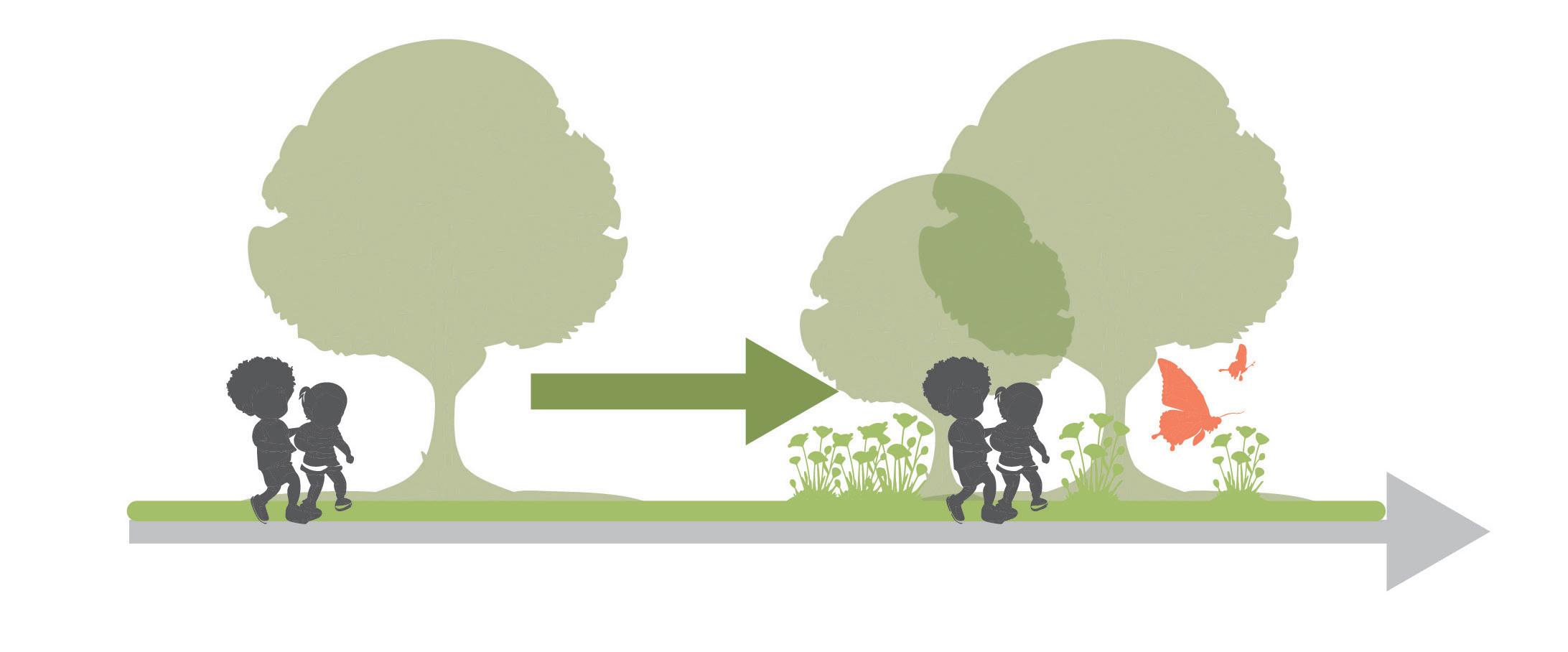
Areas to prioritize for safe and green routes
This study identified unsafe street crossings and safety concerns in the area as higher barriers for both parents and teachers for some of the greenspaces. To address these, curb extensions, clearly marked street crossings, and speed control elements (i.e., speed tables) should be prioritized throughout these neighborhoods and at major intersections where greenspaces are located. In addition, prioritizing repairing and redesigning routes from school to greenspaces may encourage schools to use nearby nature in lessons without need for bus transportation or travelling further to other natural spaces with educational spaces. However, a walkability and accessibility assessment and further community engagement is needed to identify specific areas of concern.
WHERE GREENSPACES ARE NOT ACCESSIBLE, GREEN STREETS CAN INCREASE CONTACT WITH NATURE IN THE NEIGHBORHOOD

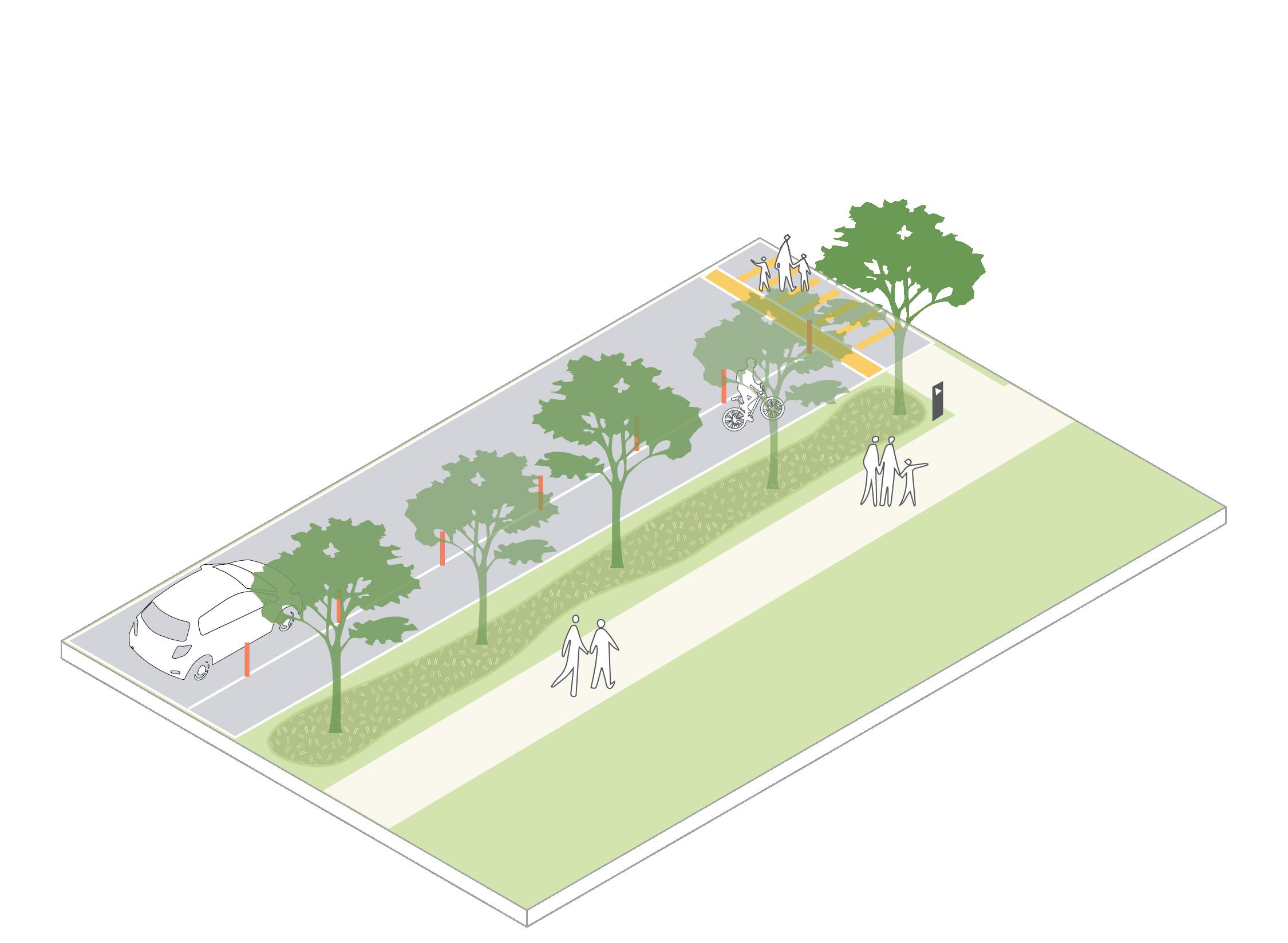
In addition, greening streets should be prioritized in neighborhoods not within a 5–10-minute walk of a greenspace. Creating vegetative buffers, such as stormwater curb extensions, can widen the space between the sidewalk and road, create a visual buffer from the road, and can improve pedestrian safety. Improving the safety of neighborhood streets and implementing green infrastructure can provide children with more nature play and physical activity opportunities in their neighborhoods. Additionally, while some neighborhoods may be located further from greenspaces, improvements to the streets can create a more pleasant pedestrian experience to these greenspaces.
connect greenspaces prioritize green streets in areas outside of a 1/4 mile from a greenspace connect the school to nearby greenspaces prioritize safe routes to school within a 1/4 mile from school budd park Gladstone Elementary
protected bike lanes vegetated buffer clear crossings & speed tables wayfinding signage to greenspaces
NEXT STEP
2
Creating safe & green routes in neighborhoods
Transform Vacant Lots
INCREASE NUMBER OF GREENSPACES
To increase the number of greenspaces in neighborhoods where space may be limited, small-scale urban greening (SSUG) strategies can be used (Loder, 2020). There is an abundance of underutilized and vacant land in Kansas City that can negatively impact communities including creating concerns for safety and feelings of neighborhood destabilization. Many cities such as Chicago and Philadelphia have established vacant lot policies and programs that aim to improve equitable distribution and access to quality greenspaces in disadvantaged communities. Common goals for transforming vacant land include providing ecological services (i.e., stormwater management), urban greening, neighborhood stabilization, crime reduction, economic revitalization, community empowerment, and improving health (Loder, 2020).

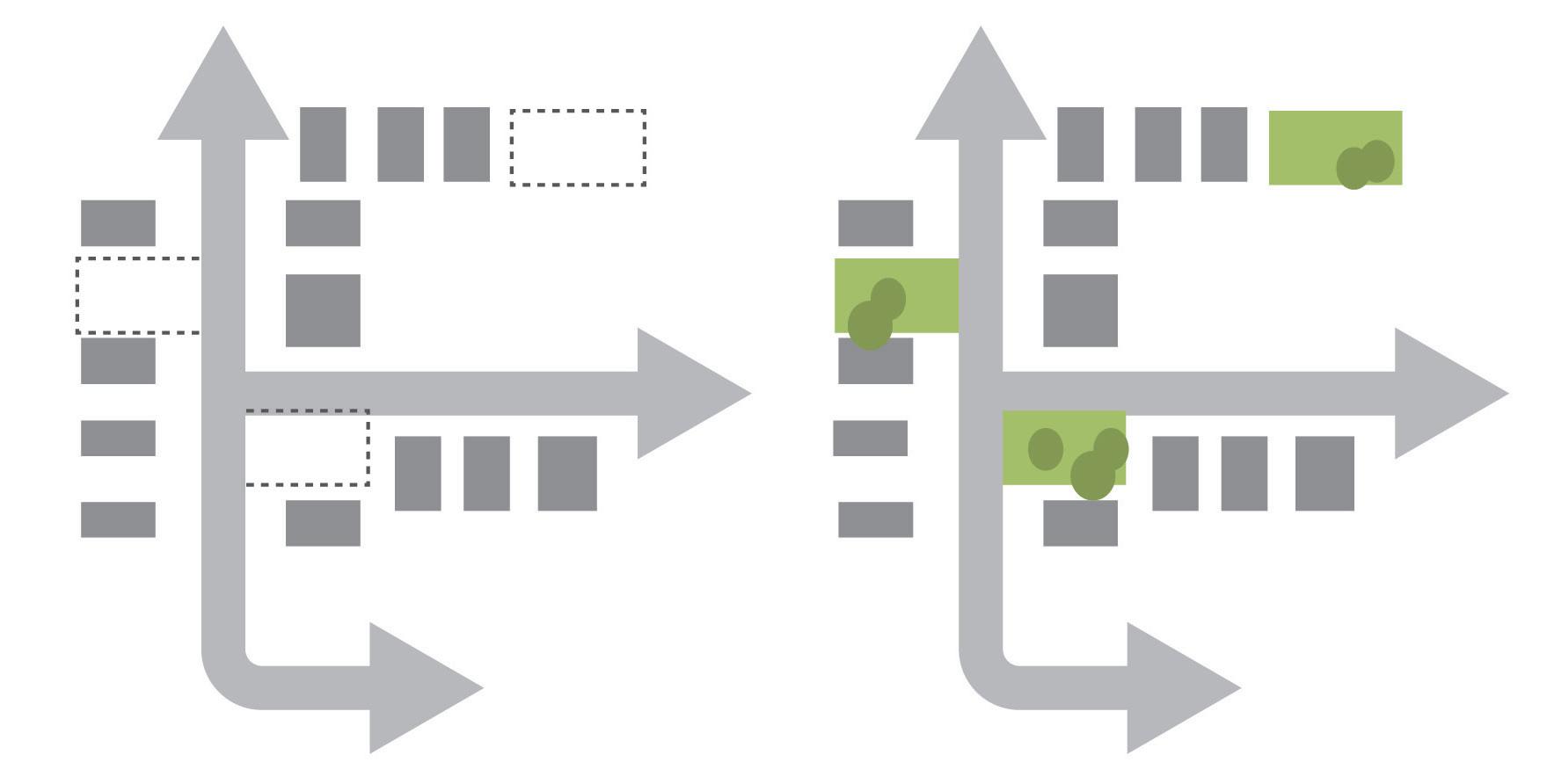
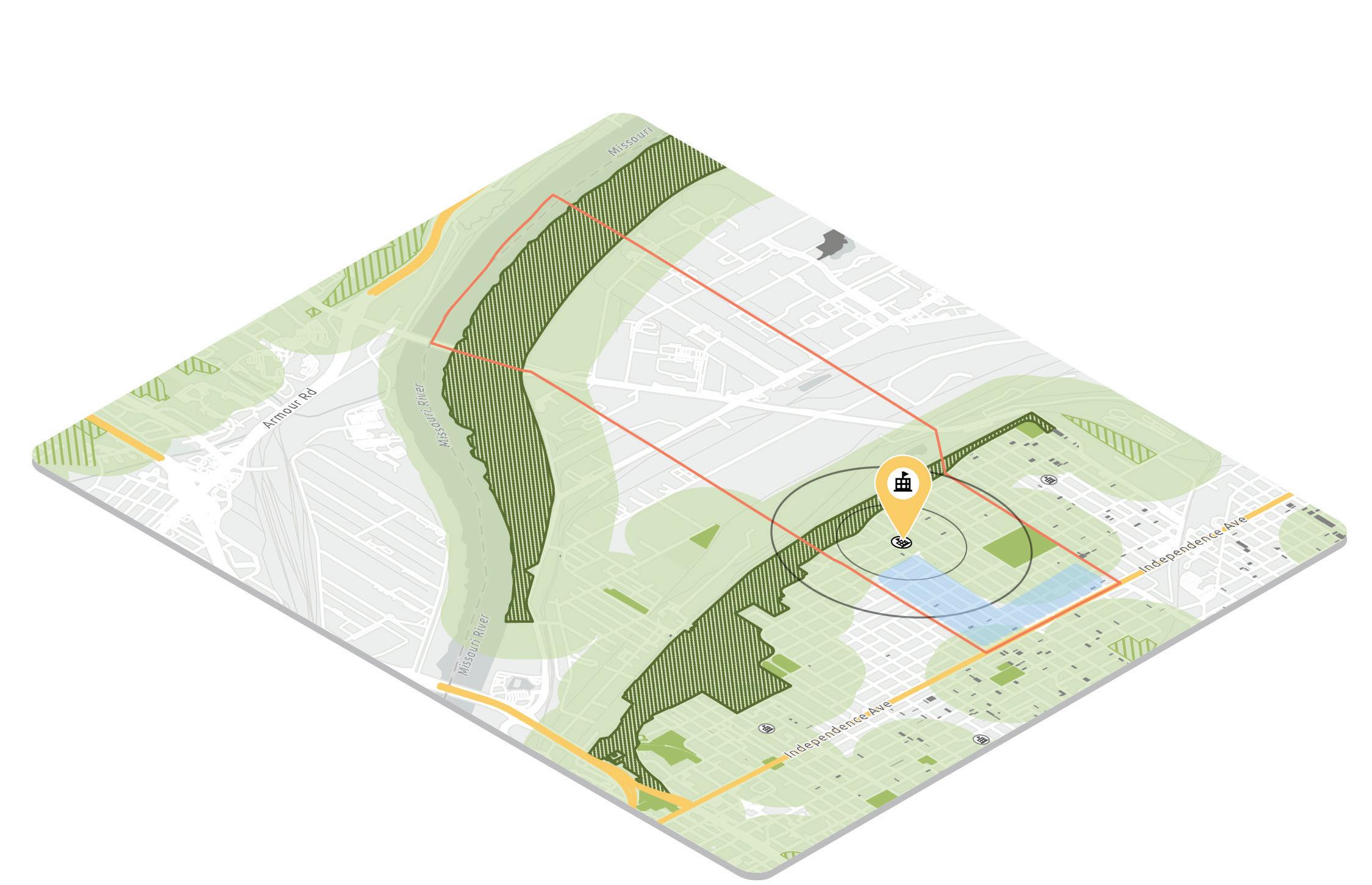

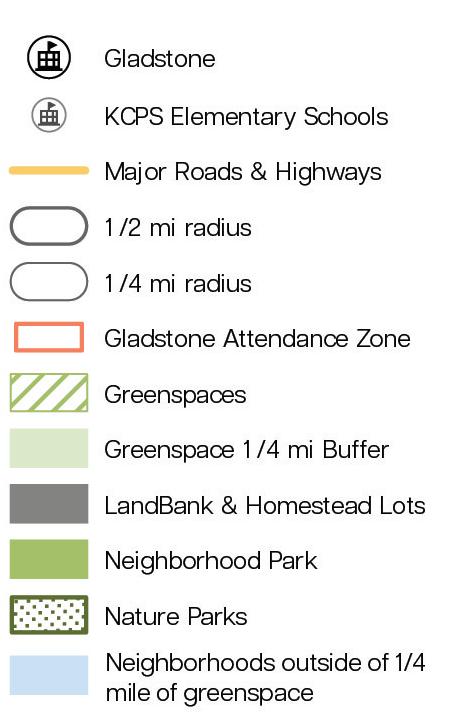
Design
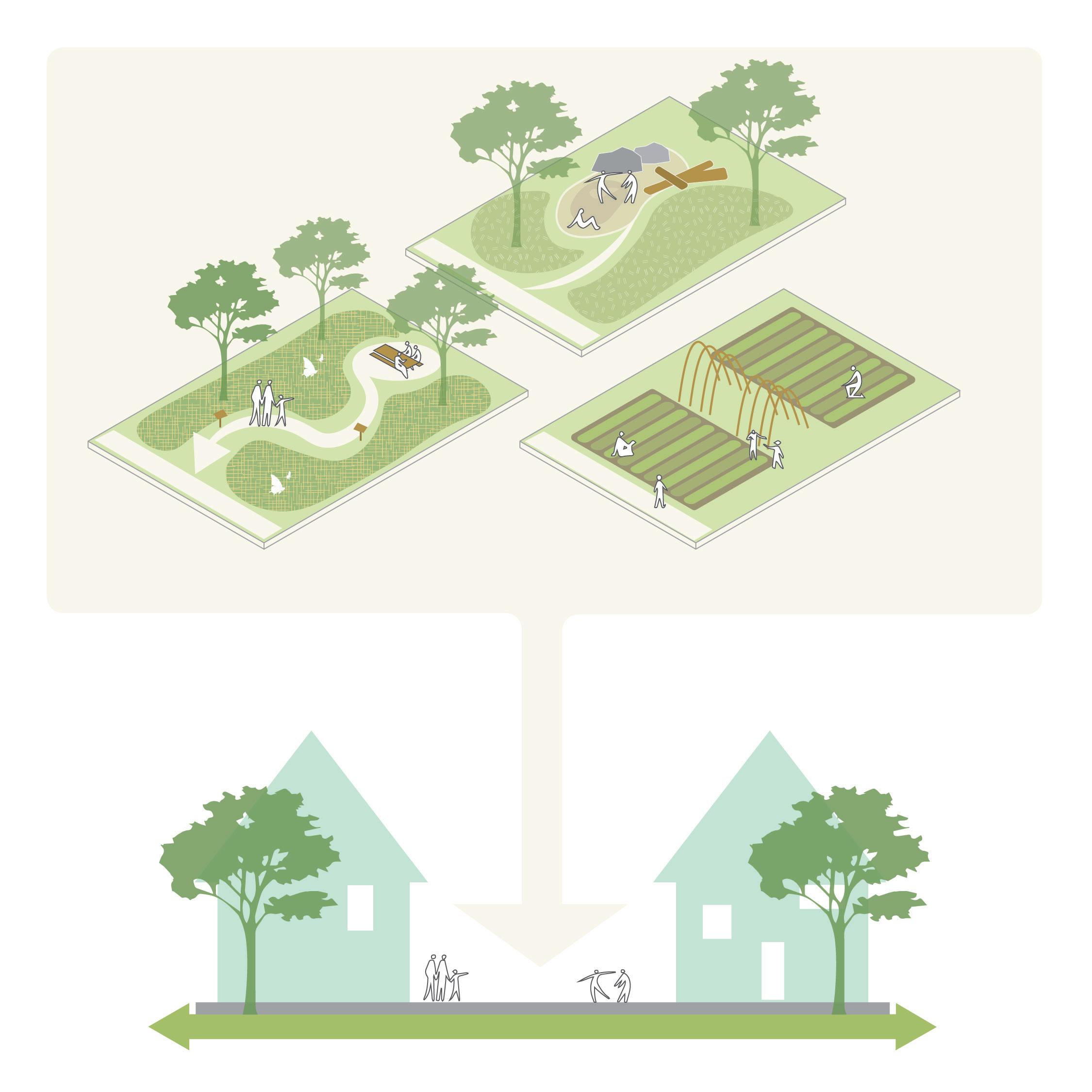
Areas to Prioritize for Vacant Lot Transformations
Transforming underutilized and vacant land has the potential to create a network of different types of greenspaces for children to be engaged in playing outdoors and in nature within their neighborhoods. It can address many of the issues and preferences identified from the data analysis including improving equitable distribution and access to nearby quality greenspaces for children in their neighborhoods, improvements to health and wellbeing, and reducing walkability and safety concerns.
There were no gardens found in these neighborhoods and both parents and teachers rarely to never take their children to gardens, so vacant lots can be suitable for introducing gardens in their community.
In areas that are not close to a park, vacant lots can be used as small parks embedded into the neighborhood. Gathering areas and nature playgrounds can activate the space for adjacent households to use.
Garden Pollinator or Rain Gardens
If vacant lots are too narrow or residents do not want an active space next to their property such as community gardens or pocket parks, a passive space such as a pollinator or rain garden can introduce nature in the neighborhood and improve perceptions of safety.
neighborhoods not within a 1/4 mile of a greenspace are a priority for vacant lot transformations vacant lots within a 1/4 mile of the school should be prioritized for school use.
LOT TYPE &
AND COMMUNITY INPUT
Pollinator or Rain Gardens Community Garden Pocket Park Vacant Lot
Concepts DEPENDS ON
SIZE
Community
Pocket Park
3
Policies & Resources
CREATE SYSTEMATIC CHANGE
To address inequities for children’s access to greenspace and contact with nature, cities must create systematic change through writing policy that prioritizes connecting children to nature. Not only should all children have access to parks, but also naturebased play and learning opportunities for a healthy childhood development. Nature should be incorporated into the school system since children spend much of their time in school and contact with nature has been shown to improve academic performance. It was found that school-specific barriers such as curriculum, district initiatives, school initiatives, funding, and training and professional development limited teachers from incorporating nature-based learning in their lessons. There is a need to guide teachers and schools for including nature in school. Support, on a larger scale, can create a citywide effort for addressing equity in children’s access and contact with nature. Cities across the nation are joining Children and Nature Network and National League of Cities in the Cities Connecting Children to Nature network. These networks help city officials with assistance in developing these strategies for children’s nature connection to incorporate in city planning, programming, and policymaking. Kansas City should become a part of the Children and Nature Network to help support efforts for increasing children’s contact with nature.
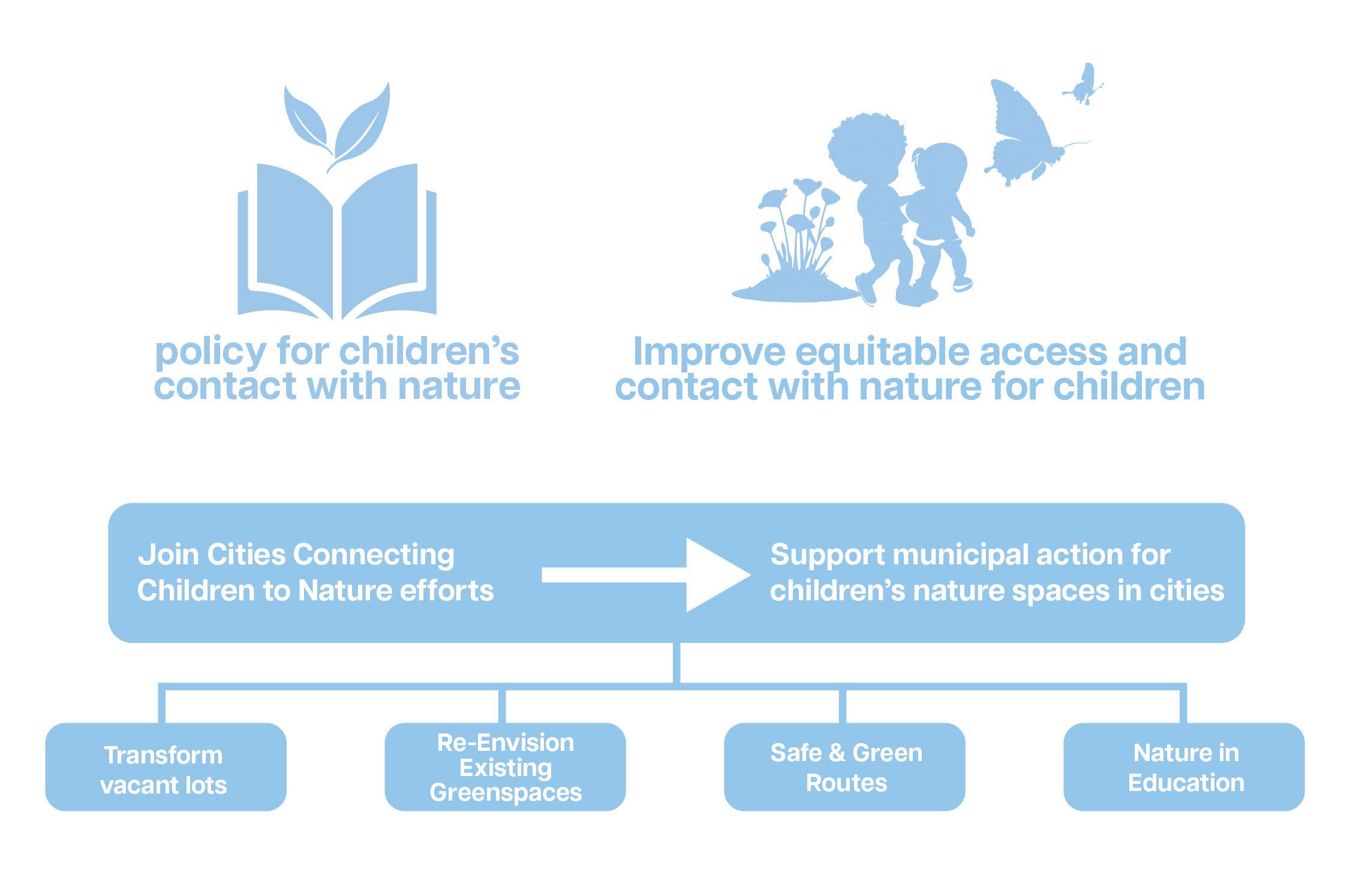
LOCAL & NATIONAL PARTNERHIPS
Improving children’s equitable access to and contact with nature is an interdisciplinary issue that requires collaboration between educators, community members, planners, landscape architects, local governments, parks and recreation, to nonprofit organizations. Each of the suggested design and planning solutions requires partnerships and resources. Below are a list of potential local and national partnerships that can work together to address the issues found in this study and the resources to do so.
Federal funding (C&NN) Resources identified by the Children & Nature Network
https://www.childrenandnature.org/resources/ federal-funding-opportunities-for-connectingchildren-to-nature/#safe-streets-and-roads-for-allss4a
KABOOM! Grants Supports children's play spaces
Missouri Department of Conservation | Community Conservation Funding
- Outdoor Recreation Infrastructure Program
- Conservation Land Acquisition Program
- Conservation Easement Assistance Program - Land Conservation Innovations Program
ReBuild KC Neighborhood Grants The neighborhood services departments provides over $4.4 million in grants to build better and stronger neighborhoods. Categories for neighborhood improvement projects include Affordable Housing Projects, Non-Profit Assistance Projects, Violence Prevention Projects, Healthy Childhood Environment Projects, Housing Assistance Projects, Job Training Projects, Strong, Healthy Community Projects. Each project can receive up to $1,000,000 in funds.
Go KC Funding allocated for maintenance and upgrade needs in the city. Funding will go to improvements at park facilities for community centers, public pools, repairing historic fountains, and upgrades to parks across the city. GO KC also has a Sidewalk Project program for repairing streets, bridges and sidewalks.
REI Environmental Grants For connecting people outside, creating space, and centering health outside.
https://kaboom.org/grants
https://mdc.mo.gov/community-conservation/ community-conservation-funding-opportunities
https://www.kcmo.gov/programs-initiatives/ rebuildkc#:~:text=ReBuild%20KC%20allocated%20 %244.4%20million%20in%20neighborhood%20 grants,Job%20Training%20Projects%207%20 Strong%2C%20Healthy%20Community%20Projects
https://www.kcmo.gov/programs-initiatives/go-kc
Partners & Resources
Partner Name Description/Role Resources Links
KCMO Parks and Rec Can play a key role in these efforts as there are city plans to create a partnership with the KCPS district, enhance the community gardens programs, acquire new space for parks, plan trails to connect greenspaces, and protect natural areas.
Kansas City Public Schools Engage with local and national partners in projects that support children's contact with nature in the community and incorporate nature in education. Heartland Conservation Alliance - a 501(c)3 organization Protect and restore natural resources.
Transform vacant lots. Engage and educate the public about restoration and protecting natural resources.
Connect people to nature.
Website https://kcparks.org/
https://www.reifund.org/
Urban Neighborhood Initiative - a Community Development Corporation (CDC) Community engagement, community development, and youth programs.
Northeast Kansas City Chamber of Commerce Advocates for plans and projects for economic and social growth in Northeast Kansas City businesses, institutions, and neighborhoods.
Mid America Regional Council (MARC) Nonprofit that organizes partners and creates plans that addresses issues such as early learning, community development, and more. Key goals include having successful people, engaged people, healthy people, vibrant places, connected places, and green places. MARC can play a key role in engaging communities, supporting teachers with training, and creating a plan for improving children’s contact with nature.
Homesteading Authority
Website https://www. heartlandconservationalliance. org/ Restoring Vacant Lots A guide for transforming vacant lots with additional resources.
Green Guard Stewardship Training Program
A free training program that educates the community about the environment and engages in classes and programs.
https://www. heartlandconservationalliance. org/restoring-vacant-lots/
Participants can include community members, officials, schools, teachers, children, and more. https://www. heartlandconservationalliance. org/green-guard-stewardshiptraining-program/
Vacant to Vibrant Guide
A guide with steps for selecting, designing, and implementing vacant lot transformations.
https://vacanttovibrantkc.org/
Website https://uni-kc.org/
About https://nekcchamber.com/aboutus/
Website https://www.marc.org/
and Land Bank For vacant lot acquisition. Homesteading Land Bank https://www.kcmo.gov/city-hall/ housing/homesteading https://www.kcmo.gov/city-hall/ housing/landbank KC Healthy Kids Helps Kansas City communities to improve children’s health and well-being through community education, local and regional advocacy, and more. There are programs that support community garden projects, engaging children in community changes, planning safe routes for physical activity, and supporting children’s mental health. Website https://www.kchealthykids.org/
4 Funding Name Description Links
 Emily Moore, MLA Kansas State
Emily Moore, MLA Kansas State

























































































